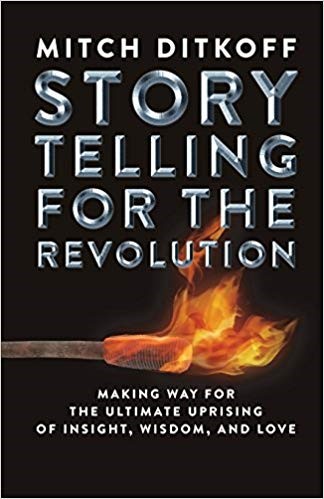TEAM LEADERS: Communicate Your Responsibilities to Your Team!

If you are a Team Leader, one of the first things you will need to do is let your team know the full scope of your roles and responsibilities.
You may think they know, but it's very likely that they don't -- at least not at the level of specificity that a high performing team requires.
And if team members don't understand what you actually DO -- and WHY you do it -- chances are good that they will resist, rebel, or reject your efforts to play your role.

1. HOW TO PROCEED: As soon as possible, meet with your team and explain the scope of your role. If you happen to be a new team leader (and your team is doubtful of your skills, leadership ability, or authority),let them know, who, specifically, in your organization, has empowered you to BE the Team Leader and that you take your responsibility very seriously.
Be sure to mention that one of your main roles is to be a helpful resource for team members -- to be there for them to help ensure that they enjoy their job, learn, grow, collaborate, and accomplish their ambitious performance goals for the year.
NOTE: Some members of your team probably perceive you as the person who is going to judge, evaluate, correct, criticize, intimidate, and hassle them. Paranoia alert! This is old school thinking. Or more like pre-school thinking.
A savvy team leader will quickly dispel this bogus notion. The faster you can let your team know that the essence of your role is be of of major support to them, the better.
2. BE SPECIFIC ABOUT YOUR ROLES AND RESPONSIBILITIES: The term "Team Leader" will mean different things to different people. Unless you explain precisely what your role is (and what it's not), you will be at the mercy of your team members' wide range of concepts, assumptions, and projections.
The best way to minimize this kind of background noise is to clearly and confidently describe, one by one, your Team Leader roles and responsibilities.
Towards that end, take a look at the list of your possible roles and responsibilities below. Note the ones that accurately describe your job and add whatever items may be missing.
-- Help your team articulate and fulfill its mission statement
-- Listen non-judgmentally
-- Share your expectations for the year
-- Establish and uphold standards of excellence
-- Facilitate the process of establishing team agreements
-- Work with team members to set performance goals
-- Observe and evaluate performance on-the-job
-- Give useful, humane, and timely feedback
-- Coach and mentor
-- Clarify team members' roles and responsibilities
-- Hold people accountable for results
-- Identify, clarify, and communicate team processes
-- Facilitate team meetings
-- Secure resources for the team
-- Ensure that team members create their Learning Plans for the year
-- Promote the teams' successes to Senior Leadership
-- Establish a simple, inspiring ideation process
-- Conduct performance reviews
-- Acknowledge individual and team progress
-- Address team challenges, conflicts, and breakdowns
-- Do everything possible to ensure the team's well-being

Posted by Mitch Ditkoff at 11:39 AM | Comments (0)
July 02, 2023Sun Tzu on Preparation

"Every battle is won or lost before it is fought." - Sun Tzu
What challenge or opportunity is coming up for you that will require a higher level of preparation than you usually make? What extra effort are you willing to make in order to prepare? What might prevent you from making the kind of effort you know you need to make?
How can you create the support you need to ensure that your preparation efforts succeed?
MitchDitkoff.com
Posted by Mitch Ditkoff at 10:04 AM | Comments (0)
August 09, 202127 Best Practices of High Performing Volunteer Organizations

Unless you've been in a coma your entire life, chances are good that, at some time in your life (maybe now?) you've been a volunteer for a non-profit organization.
That's the good news.
The not-so-good news is that many volunteer organizations, without even knowing it, sabotage the value their volunteers bring to the table and you, as a result, may have backed off, gone south, or found yourself grumbling to the other volunteers.
I've recently done some informal research on the subject and have identified 27 "best practices" high performing volunteer organizations abide by. Take a peek. Then, volunteer to share the list with the leaders of whatever volunteer organizations you would like to see succeed at a higher level. Can do?
1. Clearly (and often) communicate the vision.
2. Provide clearly written job descriptions.
3. Take the time to authentically welcome volunteers and orient them to their new role.
4. Ensure that volunteers know exactly what's expected of them.
5. Start new volunteers off small. Don't scare them off with too huge of a commitment too soon.
6. Keep the workloads manageable.
7. Communicate progress being made on a regular basis. Volunteers need to see that their efforts are having impact.
8. When there are setbacks or breakdowns, learn from them -- and share your learnings with others.
9. Be prepared so you don't waste people's time.
10. Create a trusting environment that ensures open communication, teamwork, and respect for diversity.
11. Keep everyone on your team informed of the inevitable changes (i.e. direction, policy, timelines, goals, personnel etc.)
12. Provide opportunities for volunteers to switch to different roles they might find more enjoyable.
13. Give and receive feedback (both formally and informally).
14. Provide opportunities for volunteers to learn and grow.
15. Honor your commitments (and if, for any reason, you cannot -- renegotiate them with volunteers).
16. Give volunteers the opportunity to take breaks from the project.
17. Make sure volunteers know they can say "no" if they are overextended or overwhelmed.
18. Enthusiastically acknowledge successes, especially "small wins").
19. Be kind and respectful in all your interactions.
20. Do your best to make sure everyone is enjoying the process of participating.
21. Respond to input, questions, and feedback as soon as possible. Don't leave people hanging.
22. Build some interpersonal "chat time" into your meetings and conference calls.
23. Teach volunteers, in leadership positions, how to delegate.
24. Even when you are stressed or behind deadline, take the time to make sure your emails have a feeling of warmth to them.
25. Fill out Project Briefs on all projects you are inviting volunteer participation -- and share them with volunteers.
25. Conduct exit interviews whenever a volunteer ends their participation or is asked to step aside.
26. Share your learnings from the exit interviews with other managers.
27. Follow the Golden Rule: Do unto others as you would have them do unto you.
Posted by Mitch Ditkoff at 03:01 PM | Comments (1)
May 02, 2021PRENTISS UCHIDA: Entrepreneur Catalyst

Prentiss Uchida is an Entrepreneur Catalyst. His business coaching, mentoring and consulting services, honed over 50 years of launching successful start-ups and holding management positions in various organizations has made a profound difference in the lives of countless entrepreneurs.
His heart-centered, mind-opening approach to business sparks insight, clarity, confidence, and the kind of inner knowing that enables entrepreneurs-at-the-crossroads to learn quickly, adapt, and make the kind of wise choices that lead to success.
Bottom line, Prentiss teaches people how to fish in the often turbulent waters of 21st century business. And he does so with integrity, warmth, and wisdom.
Knowing that experience is the best teacher, Prentiss establishes the kind of relationship with his clients that allows them to understand new inputs quickly, apply them to their current challenges, and mine the depths of their past experiences in a way that elicits insight.
The compass Prentiss abides by in his entrepreneurial coaching efforts? Something he calls the "feel good guide" -- the evolved, but often hidden, aspect of human intelligence that has a knack for getting to the heart of the matter quickly. Indeed, actions that originate from this state of awareness create the kind of forward movement that radically increases the odds of success.

At the core of Prentiss' business coaching is a great wisdom, honed from a lifetime of learning, service, street smarts, and a deep commitment to tapping into the source of success.
As Clifford Stoll, American Astronomer and author once wrote: "Data is not information. Information is not knowledge. Knowledge is not understanding. Understanding is not wisdom." And it is this wisdom -- translated into action -- that Prentiss helps entrepreneurs discover in themselves. The end goal is to provoke and help bring along as many entrepreneurs as possible, to their own personal success.
PRAISE FROM HIS CLIENTS:
"In just five minutes, Prentiss provided me with the information and insights I needed to clarify my path forward -- a path it would have taken me months to come up with on my own." -- Ritchie Polido
"Prentiss Uchida is the best business mentor I've ever had -- and I've had at least five before him. Bottom line, Prentiss helped me go from zero to more than $1 million in sales. His patience and understanding inspired me to continue with my business when I wanted to give up." -- Peter Turcios
"The expertise and precision of Prentiss' business coaching is incredibly rare! As a result of his efforts, I have experienced a tremendous boost of confidence. His style of coaching fully connected with my needs and directed me to what I needed to do first. Without his help I would be still procrastinating." -- Alima Brya
"Prentiss was able to evaluate my vague description of my business and get to the essence of what was wrong. He cut through my confusion and enabled me to determine where to direct my efforts. I didn't always want to hear what he had to say, but his counsel was right on. I appreciated working with someone who held me accountable, despite my excuses." -- Frank Joel
"Prentiss Uchida understands business and is able to provide insight into the heart of the matter with very little information. He provided valuable feedback that helped me evaluate my business in new ways to change my core strategies. Locked doors opened for me." -- Adam Harn
"Excellent insight and advice." -- Gregory Johnson
"Prentiss Uchida is amazing, awesome, informative, super professional and a very nice man. I am so grateful for his support. He is the kind of person I aspire to be like." -- Jennifer West
"Prentiss Uchida is a great business coach." -- Peter Campbell
"The experience, guidance and information I received from Prentiss exceeded my expectations." -- Tom Alleeson
"Prentiss Uchida is not only a great business coach, he is also a sage. For the past 30 years, whenever I got stuck or confused in the process of growing my business, Prentiss was always there for me with the kind of questions, perspective, and insights that sparked breakthroughs. Prentiss has a knack for distilling down complex matters into ways that less business-savvy people, like me, can get in a heartbeat. And he does it with kindness, clarity, and humor." -- Mitch Ditkoff
THE BACK STORY
Prentiss Uchida, born in San Jose, California, grew up on a farm and then, with his family, for three and a half years, was imprisoned in a War Relocation Center, before moving back to San Jose. He received a BA in Mathematics from San Jose State University and, upon completing college, worked for the Lockheed Missile and Space Company. During the next 50 years, Prentiss held a variety of management positions in both private and public companies. He was one of the Founders and CEO of Vector General (a pioneer in 3D graphics and CAD whose system was used in the original Star Wars movie), CEO of the Inner Game Corporation (a training and development company founded by Tim Gallwey), CEO of Secom General (a NASDAQ mini-conglomerate of automotive component manufacturers), Director of Instar Infomatique (a French medical software company), Director of Kahootz (an enterprise software company), and Managing Director of VanderBolt GmbH (a German technology transfer company). He has also crashed and burned as a commodity trader -- one more source of humility.
Prentiss is currently a mentor for SCORE, a member of the Board of Directors for the Heart Mountain Foundation, and a member of the Board of Directors of WAFA, a Denmark NGO. Previously, he has served on the Advisory Board of Stanford University's WEMA Executive Institute and on the Los Angeles Board of Directors for the United Way. Prentiss currently lives in Moorpark, California and has three grown children and four grandchildren. When he's not coaching and provoking aspiring entrepreneurs, he is practicing yoga, playing his guitar, and writing songs.
CONTACT: puchida@mac.com
Posted by Mitch Ditkoff at 10:08 PM | Comments (0)
March 16, 2020The Leader Mindset
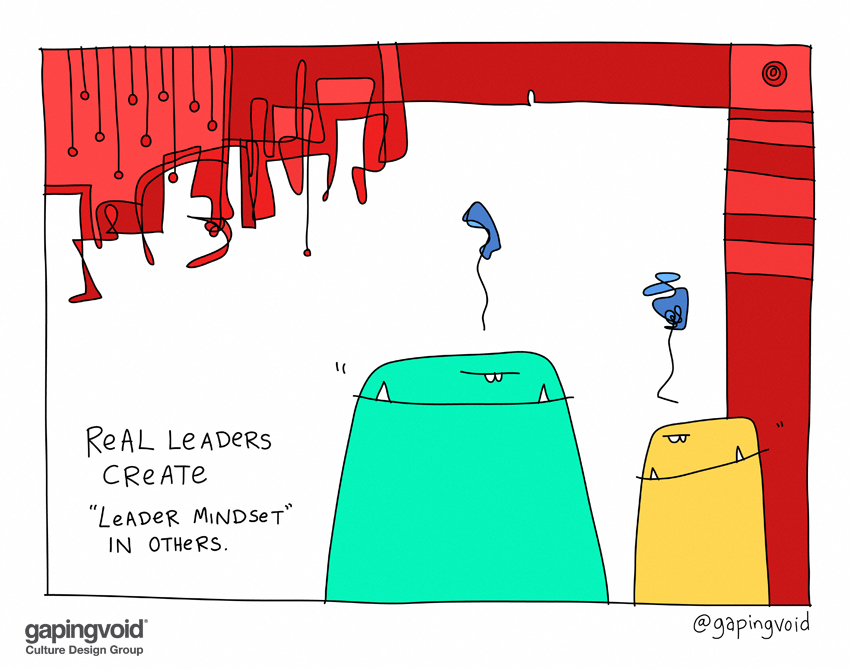
ILLUSTRATION gapingvoid
Posted by Mitch Ditkoff at 07:49 AM | Comments (0)
December 11, 2019On Creating an Innovation Mindset

If you want to spark innovation in your organization and are looking for the diamond cutters stroke, consider storytelling. Since 1987, I've tried everything under the sun to help my clients raise the bar for innovation. What I've discovered is that innovation begins in the mind and that unless people are in the right mindset, innovation will never be more than a pipe dream. Storytelling, I've learned, is the simplest, fastest, most memorable way to get people into an innovation mindset. Here's how we do it. And if you only have 90 minutes, this is how we do it. Its also boosts employee engagement.
I wrote the book
The back story
In our clients words
Posted by Mitch Ditkoff at 11:10 AM | Comments (2)
November 30, 2019Are You an Idea Addict?

There are lots of things in this world people get addicted to: alcohol, nicotine, heroin, sex, and iPhones, just to name a few. But perhaps the biggest addiction of them all is the addiction to our own ideas. Here's how it works:
We think something up. We feel a buzz. We tweak it, we name it, we pitch it, and POOF, the addiction begins.
At first, like most habits, it's a casual pursuit with a thousand positive side effects: increased energy, renewed focus, and a general feeling of well-being. Like wow, man. But then... we think about it in the shower. We think about it in the car. We think about it when people are asking us to think about other things. We even dream about it.

Soon we want everyone to know about it. We want them to feel the buzz. We want them to nod in agreement. We want them to recognize just how pure our fixation is.
If this is where it ended, it wouldn't be that big of a deal. I wouldn't be calling it an addiction. Maybe I'd be calling it an "inspiration," or a "commitment" or a "visitation from the Muse." But it doesn't end there. It goes on and on and on and on -- often to our own detriment.
If you are launching a new, creative venture, of course, you want to conjure up cool ideas. That's a good thing. But if you cling to ideas just because they're yours, or just because you've invested major time and energy into in them, then it's time to take a good look of what "intoxicating ideas" of yours it might be time to let go. Commitment is one thing. Addiction is quite another.
What hot, new idea of yours might you be just a little bit too addicted to?
Idea Champions
Brainstorm Champions
MitchDitkoff
Posted by Mitch Ditkoff at 08:20 PM | Comments (2)
October 06, 2019A Real Life Example of the Power of Giving Feedback

Most Fortune 500 companies have some kind of corporate strategy in place for ratcheting up their innovation efforts. Consultants are hired. CEOs give pep talks. And internal initiatives are launched.
To the casual observer, it all looks good, but few of these initiatives ever amount to anything In fact, research indicates that 70 percent of all change initiatives fail.
Why such a low percentage? It depends on who you ask. Senior leaders see it as a workforce issue. The workforce sees it as a senior leader issue. Consultants see it as an issue their company is best suited to resolve. And the occasional in-house astrologer sees it as a Gemini in Pluto issue. Bottom line, nobody really knows.

Here's how I see it: one of the biggest (and least addressed) reasons why most change initiatives fail can be traced back to the cro-magnon way most innovation-seeking people give and receive feedback -- especially when it comes to pitching high concept ideas.
Case in point: Some years ago, Lucent Technologies asked me to facilitate a daylong "Products of the Future" ideation session for 75 of their best and brightest. The pay was good. The challenge was compelling. And I was going to have carte blanche to design the session just the way I wanted.
Or so I thought.
The woman who had contacted me, I quickly found out, reported directly to the CEO. So far, so good. And her concept of the session was spot on -- that the CEO and his Direct Reports (a new rock band?), would make an appearance at the end of the day to listen to five BIG IDEA pitches and then give their feedback, real-time.
Theoretically, this made perfect sense. But theory and reality are two very different things -- kind of like the difference between asking your teenage daughter to clean up her room and her actually doing it.
The harsh reality is this: The vast majority of Senior Leaders are not very skillful when it comes to giving feedback -- especially in response to ideas that challenge the status quo. "Feedback," for them, has become code for "With all due respect, let me tell you why your idea sucks".
As a facilitator of high profile brainstorming sessions, I cannot, in good faith, allow this all-too-predictable dynamic to play itself out. Not only will potentially profound ideas be prematurely dismissed, the hard-working, brilliant people who have spent all day generating and developing these ideas will become royally pissed, disempowered, humiliated, passive/aggressive, and depressed. The result? Very few of them will want to participate in future sessions.
So I told the consultant-seeking woman from Lucent that I, in service to the outcomes she was about to hire me to ensure, needed to meet with her CEO so I could teach him and his team how to give effective, humane feedback to a roomful of 75 future product generating optic fiber geniuses.
 "Impossible!" was her response. "Our CEO is very busy man -- and besides... he doesn't like consultants."
"Impossible!" was her response. "Our CEO is very busy man -- and besides... he doesn't like consultants."
"Got it," I said, quickly assessing my options. "And thank you, so much, for your kind invitation to facilitate the session, but I must respectfully decline" -- and, with that, I began packing up my briefcase.
This, shall we say, caught her slightly off guard. "I... don't understand where you are going with this," she replied.
"Look," I said. "If you want to get meaninful results from an all-day brainstorming session, especially if you are flying people in from who knows where, we've got to be absolutely sure that the feedback at the end of the day is done well. I am not going to walk 75 of your best and brightest people off the plank."
I could tell that my unexpected feedback was registering. "OK, OK...but the best I can do is get you five minutes with him during the coffee break just before the report outs".
"Great," I said. "I'll take it."
Fast forward two months.
From 8:30 am -- 3:00 pm, 75 of Lucent's most brilliant technologists conjured up products that made my head spin. The room was abuzz with glorious possibilities. The sense of accomplishment was palpable. At 2:45 they selected five of their best ideas and summarized them on flipcharts. At 3:00, it was time for coffee and sugar, me craning my head for the CEO and his merry band of direct reports.
I envisioned him to be a tall man, silver-haired, with a large Rolex and a steely look in his eyes -- someone who might be good friends with the Governor and eventually have his portrait hanging in the lobby at headquarters. He was, much to my surprise about 5'6", wearing a Mickey Mouse t-shirt, loafers, and no socks. My kind of guy.
"Rich," I began, extending my hand. "Welcome, Mitch Ditkoff here from Idea Champions, facilitator of today's extraordinary ideation session, "how would you like to learn a simple technique in the next five minutes that will not only take all the dread out of giving feedback, but spark some seriously powerful idea development on the spot?"
He looked at me as if I'd just given him the holy grail. "You're on!"
"Great. Here's how it works," I began. "When an idea is pitched, first say what you LIKE about it -- the upside, what's promising. After a few genuine likes, then express your CONCERNS -- the stuff you probably wanted to say in the first place. But for each concern you express, it will be your responsibility to follow it with a SUGGESTION, a way that would resolve your concern and keep the idea alive Got it?"
"Got it."
"Oh... one more thing, Rich. If you forget to use the method, do I have your permission to remind you?"
"Absolutely".
The senior team took their place on stage, sitting behind a table, draped in black, that reminded me of the Nuremberg Trials. The 75 brilliant brainstormers took their seats at round tables -- everyone attentively listening to me describe the feedback process that was just about to unfold.

The first BIG IDEA pitch was excellent -- a compelling idea for a telecommunications platform of the future that was utterly mind blowing. The audience applauded, I acknowledged the presenter, and then gave the floor to the CEO, reminding him to use the feedback technique I'd taught him just a few minutes ago -- which he proceeded to do for, oh, maybe 30 seconds or so.
After that? It was Apocalyse Now meets The Godfather, with a little Don Rickles in Vegas thrown in for good measure, a scene I'd witnessed countless times before in corporate America -- the kneejerk, reptilian-brained, go-for-the-jugular tendency most senior executives have to focus on what's wrong with a new idea before what's right.
Speaking into the mic in my best baritone imitation of the Wizard of Oz, I quickly intervened.
"Oh Mr. CEO of a very large and profitable telecommunications company. Remember the LCS technique! First your LIKES, then your CONCERNS, then your SUGGESTIONS."
In an optic fiber nanosecond, he sheepishly smiled, thanked me for the reminder, and returned to the technique.
The rest of the session went off without a hitch. Five powerful ideas got pitched. Seven of Lucent's top executives weighed in with insight, honesty, and graciousness. And 75 aspiring innovators experienced something they had probably never experienced before -- that it was possible to spend all day brainstorming "out there" possibilities and get the kind of feedback from senior leadership that was honorable, empowering, easy-to-listen to, and immediately helpful.
SO WHAT? Ever hear the phrase "ideas are a dime a dozen." Of course you have. It's one of the classic truisms we were all brought up to believe. That old saw, however, is less about ideas being inconsequential, than it is about people not knowing how to elicit their value. Granted, not every idea is worth developing, but far too many good ones are lost along the way because the person to whom the idea is pitched is blinded by their own knee jerk reactions.
The literature is filled with examples of great ideas whose value was not immediately recognized. The steam engine. The MacIntosh. FedEx. And the Post-It Note just to name a few. All of them were pitched to the "powers-that-be" and all were victims of knee jerk, naysaying, idea killing behavior. Yes, it's true, many senior leaders beat the drums for "out of the box thinking". But when push comes to shove, as it often does, their drumming is more like fingernails on the edge of an office desk than a conga player with fire in his eyes. So let's give our senior leaders what they need to make the shift from theory to practice -- and that is a simple method for them to respond to new and untested ideas in a way that increases the odds of innovation actually happening.
NOW WHAT? Think about your style of responding to new ideas. Do you listen? Do you pause long enough to see the seed of innovation? Do you give meaningful feedback in a humane way? And what about your organization? Do people know how to give and receive feedback? Do they take the time? Does the process increase the odds of innovation becoming a reality? If not, what can you about it this week to turn things around?
Posted by Mitch Ditkoff at 06:46 PM | Comments (0)
September 13, 2019How to Escape Education's Death Valley
Posted by Mitch Ditkoff at 03:10 PM | Comments (0)
September 09, 2019The Perfect Want Ad
Simon Sinek cuts to the chase. This is all you really need to know if you are trying to attract the right people to your team, project, or organization. And notice how he used the Earnest Shackleton story to make his point. Telling the right story is a very powerful way to deliver a message that sticks.
Big thanks to Fazeel Arain for the heads up!
Idea Champions
Posted by Mitch Ditkoff at 03:02 AM | Comments (0)
March 20, 2019Big Blues From the Viagra People

In 1999, I conceived and co-founded (with Paul Kwicienski) the world's first interactive business blues band, Face the Music.
The concept was a simple one: help organizations increase teamwork and decrease complaint by getting employees to write and perform original blues songs.
The concept resonated with a lot of industries, especially Big Pharma.
Oh yeah, they had the blues, lots of blues, like the "Now We Gotta Compete with Generic Drugs from Canada Blues," and the "No One Trusts the Drug Companies Anymore Blues," and the always popular, "Our Pipeline Is Empty, But Our Inbox is Full Blues."
So we weren't all that surprised when Pfizer came calling...
They had a big conference coming up and wanted to do "something different" to engage participants -- all of whom were high ranking business leaders.
Though our approach seemed risky to them at first, our testimonials from other Fortune 500 companies were proof enough we were the real deal for them to sign on the dotted line.
And so they did.
Unlike most bands -- or business simulations, for that matter -- our service began long before we took the stage.

For each client wanting the complete experience, we'd write a custom blues song weeks before -- a kind of musical caricature of their company that we'd perform to kick off our performance -- a modern day Greek Chorus routine that loosened up audiences while modeling the message of the evening -- to speak (or in our case, sing) the truth.
And though we always shared our lyrics with clients long before an event, rarely were we asked us to modify what we wrote.
Pfizer was a different story.
From their perspective, our lyrics were "incendiary, politically incorrect, and might be taken the wrong way."
Customer-focused as we were (and not wanting to blow a good pay day), we revised our lyrics overnight and submitted version 2.0 the first thing in the morning.
Pfizer didn't like our new version, either. Or version 3.0, 4.0, or 5.0.
After five failed attempts, we decided to drop the custom song and focus on the classic blues songs that made up the bulk of our play list.
But doubt had crept into our client's mind. He was now officially nervous and wanted to see the lyrics to all our songs.
"Piece of cake," we reasoned to ourselves. The lyrics we'd be sending him had been performed for more than a hundred years all over America and were a huge part of the DNA of the nation.
True. But they weren't part of Pfizer's DNA. Our client had major issues with every song we sent them.
So we emailed him the lyrics to another ten classic blues songs. He rejected those, too.
Now, we had the blues. Like the legendary Robert Johnson, we stood at the crossroads, Blackberries and guitars in hand.
"Gentlemen," I began the damage-control conference call in the most corporate voice I could muster, "with all due respect, you have just rejected the lyrics of the most popular 20 American blues songs from the past hundred years. Remember, you are engaging the services of a blues band, not a polka band. You've got to have more trust in us."
Ooooh... the "T" word!
They hemmed. They hawed. Them hemmed again. And then with a semi-shrug of their collective shoulders and the growing recognition that their event was just a few days away, they chose the seven tamest songs and gave us a tepid thumbs up.
"But remember!" they warned, "the show must end no later than 9:30 sharp. Not a minute more."
Show time!
When we got to the venue, I could tell we were in for an interesting night.
Though our client greeted us pleasantly enough, something was off. Outwardly, he was fine. Inwardly, he was anxious, uptight, constricted, nervous, sweating, and silently obsessing about how he was going to cover his ass should his worst nightmares about the evening come true.
The band picked up on his mood and immediately tightened up.
Knowing that good music doesn't issue forth from tight musicians, I sent the band backstage for a glass of wine and some small talk while I filibustered with the client -- the theater now rapidly filling with hundreds of people who made a lot more money than we did.

"Remember," the client reminded me again before the lights went down, "the show must end at 9:30 sharp!"
The band's first two songs that night were lame. Very lame. Channeling the tension of our neck-on-the-line client, the band was playing it safe -- not exactly a formula for foot stomping blues.
By the third song, thank God, the band found its groove. The audience relaxed and the songs they wrote and performed were some of the funniest we'd heard in a while.
I looked at my watch. It was 9:27. Quickly, I signaled the band to wrap things up when, out of the corner of my eye, I noticed the client making his way to the stage.
Actually, "making his way" wasn't the right phrase to describe his approach. "Storming the stage" was more like it.
I looked at my watch again. Now it was 9:28 and the client was getting closer by the nanosecond. I spoke faster, much faster, doing my best to finish before the bewitching hour
Two sentences from closure, the man bounds up the stairs and lunges towards me.
"Keep playing!" he blurts. "Tell the band to keep playing! This is really going well! Forget the 9:30 deadline. Keep playing!"
I signal the band and they segue into BB King"s "Let the Good Times Roll" -- the 12-minute version. South Side Denny takes off on a blistering guitar solo.
South Side Slim is wailing at the top of his lungs. Screaming Sweet Pea Fradon is bringing down the house. Blind Lemon Pledge is on top of his game.
Everyone in the audience is singing and dancing and clapping and laughing.
The pharmaceutical blues? Gone. At least for the moment
Excerpted from Storytelling at Work
For more on Face the Music, click here or here.
Check out our Six Sigma Blues.
Go beyond the business blues keynotes
Posted by Mitch Ditkoff at 01:56 AM | Comments (0)
December 09, 2018The Best Executive

Al Siraat College
34 Quotes on Leadership
Idea Champions
Posted by Mitch Ditkoff at 03:58 PM | Comments (0)
November 05, 2018We Need More Agile Leaders!
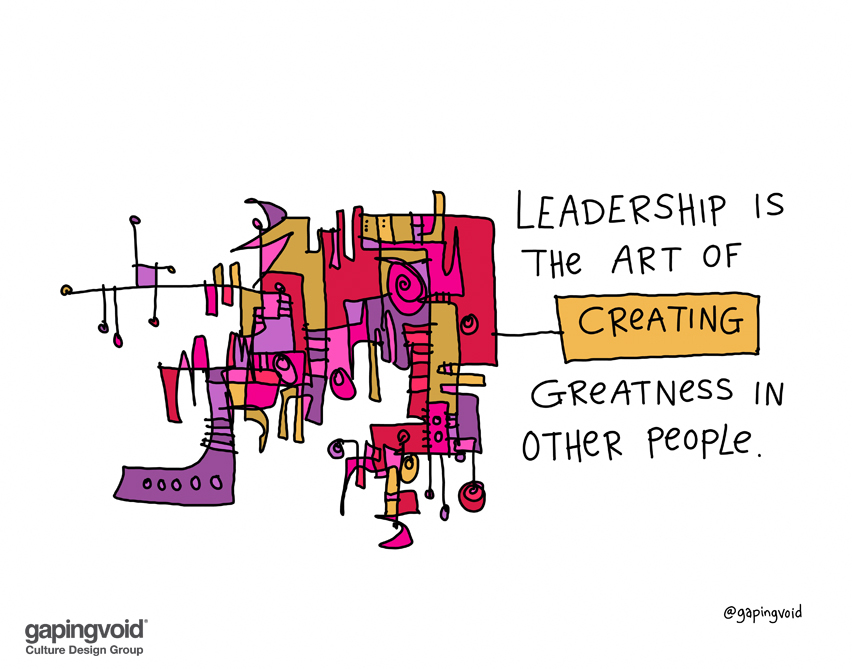
Each and every day in corporate America, new technologies, new world markets, and new competitors arise at a faster pace than ever before. Forget about 5-year strategic plans. Those days are over. These days, organizations barely take the time to look 12-months into their future. And, as a result, senior teams end up rushing through their strategic planning process. Indeed, all-too-often, the so-called light at the end of the tunnel is nothing more than an oncoming train no one has a ticket for.
Rushing through your company's strategic planning process just to keep the business afloat is not a good idea. Not only does it stifle innovation and stress people out, it threatens next year's profitability. And then? It's only a matter of time before stagnation sets in, 11th hour troubleshooting heads its ugly rear, and the predicable blame game begins.
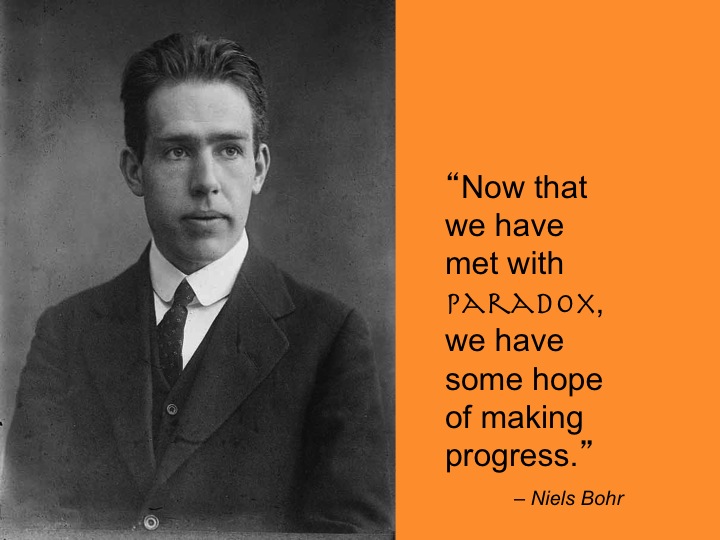
The alternative? Help your senior teams become agile. In the immortal words of Charles Darwin, "It is not the strongest of the species that survives, nor the most intelligent. It is the one that is most adaptable to change."
Agile leaders are skillful at responding to the demands of accelerating change. They know how to deal with the inevitable uncertainty, ambiguity, and chaos that accompanies it. Dealing with change is not a problem for them. Nor is it a surprise or something to be avoided. Not only do agile leaders understand the phenomenon of change, they embrace it. And even more than that, they are able to help others navigate their way forward with clarity, insight, and a positive outlook.
Agile leadership is not a binary phenomenon. It is not an either/or phenomenon. Rather, it is a both/and phenomenon -- the ability proceed with clarity and power even when there is no path in sight.
Bottom line, agile leaders have the mindset, skills, and expertise to make wise choices on the fly. They know how to focus, empower, and inspire others. They are discerning, intentional, courageous, collaborative, and able to see the forest for the trees.
Simply put, agile leaders know how to balance the long-term with the short-term. And perhaps most importantly, they know how to create advantage in the marketplace by helping their teams bring their "A" game during times of transition, ambiguity, and change.
The Agile Leadership/Agile Teams workshop
The Seize the Future workshop
Idea Champions
Posted by Mitch Ditkoff at 05:11 PM | Comments (0)
October 19, 2018The Return of Idea Champions Extraordinary Co-Founder!

Idea Champions is thrilled to announce the full return of Co-Founder, Steven Raymond McHugh to our roster of innovation consultants, trainers, facilitators, and change agents.
Steven and I (Mitch Ditkoff) founded Idea Champions 30 years ago and have delivered services to a wide variety of forward-thinking organizations since then. Bottom line, Idea Champions would not have materialized without Steven's brilliance, wisdom, energy, humor, vision, soulfulness and love of coffee. As far as facilitators of group process goes, he is in the 99th percentile of WOW. Tuned in, totally engaging, awake, and skillful beyond the norm. I have learned a lot from him and continue to do so.
Ten years after Steven and I started Idea Champions we decided to go our separate ways for a variety of reasons that were not necessarily reasonable at the time, but needed to happen. In the interim, we have stayed in touch -- as friends, fellow change agents, and referring sources. Now the wheel has turned and we are back in the saddle again -- a phenomenon of possible great value to you and your organization.

Phase One of Steven's return to Idea Champions includes the facilitation of two game-changing workshops and trainings for our clients: Seize the Future and Agile Leadership/Agile Teams.
If either of these interest you, feel free to call us at 845.679.1066 or email: info@ideachampions and Steven will get back to you within 24 hours to explore the possibilities. If you are looking to raise the bar for innovation, increase leadership capabilities, and get the collaboration juices flowing, this is for you.
Idea Champions
Our clients
What our clients say
Posted by Mitch Ditkoff at 09:59 AM | Comments (0)
September 06, 2018A Big Shout Out to All of the Teachers on the Planet

In the past 12 months I have spent 90 days working very closely with Al Siraat College, an Australian school in the Islamic tradition, located in the suburbs of Melbourne. Working at the school for a month at a time, I've had an extraordinary opportunity, to see, first hand, up close and personal, both the glory and the challenge of what it takes be a teacher in 2018 and also what's required to establish the kind of school culture that is conducive to real learning.
On the glory side of the equation, there is a lot to acknowledge -- countless opportunities for teachers to make a difference in the lives of the next generation of movers and shakers... never-ending chances to open eyes, open minds, and open hearts... chances to listen, connect, nurture, empower, encourage, inspire, awaken, educate, and be a catalyst for positive change. The audience? Kids! Children! Teenagers! Multi-cultural keepers of a very special flame -- the hope for our world. The ones Thomas Edison referred to when he said that "the greatest invention in the world is the mind of a child."

On the flip side of the equation?
The extremely hard work required of teachers to deliver real value to class after class of kids who sometimes would rather be playing, texting, sleeping, googling, eating, watching TV, daydreaming, or any number of other pursuits far more interesting to them than algebra or sitting quietly at their desks. Toss in a few dozen X factors like one-parent families, stress, English as a second language, a multiplicity of learning styles, social media, distractability, bullying, and the rites of passage most kids go through daily and you have a formula for a very challenging profession.
I want to take this moment in time to deeply THANK all of the teachers in the world for taking on the challenge of educating our children -- and for staying with it even when it seems like nothing they do is noticed, working, or appreciated.
I also want to take this moment to thank all of the hard working teachers of Al Siraat for giving it their best day after day after day after day. I know it's not easy. I know it's not always fun. I know the path forward isn't always clear. But the efforts you are making ARE bearing fruit and will CONTINUE to bear fruit in ways you have not yet imagined. Stay with it! Hang in there! Trust the process! As they say, "Rome wasn't built in a day."
And to the Staff, Administrators, Directors, and Founders of Al Siraat, allow me to take this unofficial cyberspatial moment to acknowledge YOU for all your vision, commitment, perseverance, resilience, flexibility, collaboration, courage, and willingness to learn. The world needs more people like you! Stay with it! You are being called and you are responding, with nobility, love, and respect to the source of that call.
Thank you all, from the bottom of my heart, for the opportunity to be a part of what you are creating -- what one day may very well become a model for Islamic education in the West.
Heads of Learning
School Coordinators
Heads of Year
Middle Years Homegroup Teachers
Senior Years Homegroup Teachers
Junior Years Homegroup Teachers
Subject teachers
Specialist teachers
Counseling Services and Learning Support
Religion and Islamic Studies
Customer support
IT Support
Site Team
College Management
Executive Team
Posted by Mitch Ditkoff at 02:52 AM | Comments (0)
August 28, 2018Be Yourself!
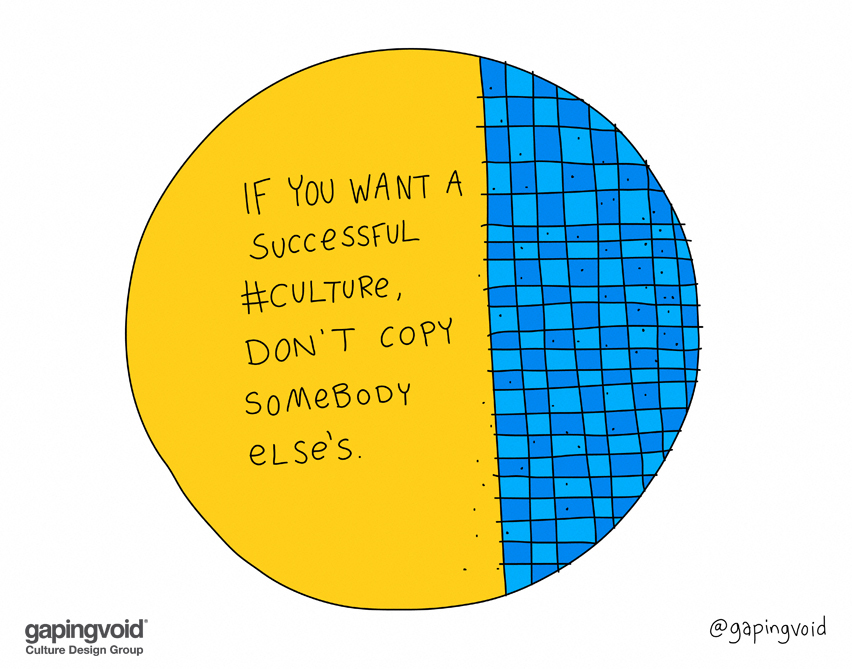
Your company is unique. Honor that uniqueness. While there is nothing wrong with benchmarking other company's best practices, be mindful not to mindlessly graft them on to your company's culture. Be who you are!
Illustration: gapingvoid
Idea Champions
Help for being who you truly are
The author of the book
Posted by Mitch Ditkoff at 06:15 PM | Comments (0)
August 10, 2018What Business Leaders Can Learn from Sitting in an Orchestra
Roger Nierenberg - Living the Classical Life: Episode 47 from Elyria Pictures on Vimeo.
This is brilliant stuff. As it turns out, the creator of the Music Paradigm (Roger Nierenberg) and I went to elementary school, junior high school, high school, and summer camp together. We reconnected a few years ago after a long hiatus. If you are looking for a way to help the leaders in your organization make a quantum leap, consider The Music Paradigm.
Posted by Mitch Ditkoff at 03:24 PM | Comments (0)
June 20, 2018How to Spark Innovation in Your Company in 10 Minutes Per Week

Do you work in an organization that is trying to raise the bar for innovation, teamwork, storytelling, and leadership, but doesn't have the budget to pay for trainings, keynotes, and workshops? Here's an alternative -- Idea Champions' Micro-Learning for Innovators service. It all happens online. At your own pace.
The price? YOU decide on the value of our service and make us an offer. 95% of the time we go with what our prospective clients suggest. 5% of the time we decline. Interested? mitch@ideachampions.com
Posted by Mitch Ditkoff at 10:23 AM | Comments (0)
April 26, 2018Micro-Learning for Innovators in Just 15 Minutes Per Week
 If you are looking for a simple, inexpensive way to spark innovation in your organization in just 15 minutes per week, here it is. No workshops. No trainings. No keynotes. No complicated idea management software. No headbanging. And the first three companies that respond to this post get to name their own price. Here's what one of our happy clients says about this innovative service of ours.
If you are looking for a simple, inexpensive way to spark innovation in your organization in just 15 minutes per week, here it is. No workshops. No trainings. No keynotes. No complicated idea management software. No headbanging. And the first three companies that respond to this post get to name their own price. Here's what one of our happy clients says about this innovative service of ours.
PS: If you want to know how much it costs, text me at 845.389.9096 and I'll let you know ASAP.
The creator of this service
The company he co-founded
This might be included
10 ways to enable innovation in the workplace
Another way of thinking about time
Posted by Mitch Ditkoff at 08:24 AM | Comments (0)
April 01, 2018The 10 Personas of an Effective Brainstorm Facilitator

Allow me to make a wild guess. You have participated in more than a few brainstorm sessions in your life. Yes?
And allow me to make another wild guess. Many of those sessions left you feeling underwhelmed, over-caffeinated, disappointed, disengaged, and doubtful that much of ANYTHING was ever going to happen as a result of your participation. Yes, again? I thought so.
There's a ton of reasons why most brainstorming sessions under-deliver, but the main reason -- the Mount Olympus of reasons (drum roll, please....) is the brainstorm facilitator. Armed with a short list of ground rules, a flipchart marker, and a muffin, most brainstorm facilitators miss the mark completely.
The reason has less to do with their process, tools, and techniques than it does with their inability to adapt to what's happening, real-time, in the room. In an all-too-professional attempt to be one-pointed, they end up being one-dimensional, missing out on a host of in-the-moment opportunities to spark the ever-mutating, collective genius of the group.
If only our well-intentioned brainstorm facilitators could abide by the words of Walt Whitman, when he confessed that he "contained multitudes."
Translation? If you or anyone you know is going to lead a diverse group of time-crunched, opinionated, multi-tracking, people through a process of originating breakthrough ideas, DON'T BE A ONE TRICK PONY! Be a multitude -- or, at the very least, be multi-faceted. Let it rip. Hang ten. Pull out the stops.
Use your right brain and your left. Let all the cats out of the proverbial bag -- and by so doing, exponentially increase your chances of sparking brainpower, brilliance, and beyond-the-obvious ideas.
OK. Enough bloggy pep talk. Let's get down to business. Take a few minutes now to rate yourself, on a scale of 1-10, for how skillful you are at embodying the following personas of a high flying brainstorm facilitator. Then tune into your biggest strength and ask yourself how you can amplify that quality. Then identify your biggest weakness and figure out how you can improve in that arena.

1.CONDUCTOR
A skilled brainstorm facilitator knows how to orchestrate powerfully creative output from a seemingly dissonant group of people. In the conductor mode, the facilitator includes everyone, evokes even the subtlest contributions from the least experienced participant, and demonstrates their commitment to the whole by offering timely feedback to anyone who "gets lost in their own song."
2.ALCHEMIST
A good brainstorm facilitator is able to transmute lead into gold -- or in modern terms -- knows how to help people "get the lead out." This talent requires an element of wizardry -- the ability to see without looking, feel without touching, and intuitively know that within each brainstormer lives a hidden genius just waiting to get out.
3.DANCER
Light on their feet, brainstorm facilitators move gracefully through the process of sparking new ideas. Able to go from the cha-cha to the polka to the whirling dervish spinning of a brainstorm group on fire, savvy facilitators take bold steps when necessary, even when there is no visible ground underfoot. "The path is made by walking on it," is their motto.
4. MAD SCIENTIST
Skillful brainstorm facilitators are bold experimenters, often taking on the crazed (but grandfatherly) look of an Einstein in heat. While respecting the realm of logic and the rational (the ground upon which most scientists build their homes), the enlightened facilitator is willing to throw it all out the window in the hope of triggering a "happy accident" or a quantum leap of thought. Indeed, it is often these discontinuous non-linear moments that produce the kind of breakthroughs that logic can only describe, never elicit itself.

5.DIAMOND CUTTER
Fully recognizing the precious gem of the human imagination (as well as the delicacy required to set it free), the high octave brainstorm facilitator is a craftsman (or craftswoman) par excellence -- focused, precise, and dedicated. Able to get to the heart of the matter in a single stroke without leaving anything or anyone damaged in the process.
6. ACTOR
Brainstorm facilitators are "on stage" whether they like it or not. All eyes are upon them, as well as all the potential critical reviews humanly possible. More often than not, the facilitator's "audience" will only be moved to act (perchance to dream) if they believe the facilitator is completely into his or her role. If the audience does not suspend this kind of disbelief, the play will close early and everyone will be praying for a fire drill or wishing they were back home eating a grilled cheese sandwich.
7.ENVIRONMENTALIST
Brainstorm facilitators are the original recyclers. In their relentless pursuit of possibility, they look for value in places other people see as useless. To the facilitator in full mojo mode, "bad ideas" aren't always bad, only curious indicators that something of untapped value is lurking nearby.
8. OFFICER OF THE LAW
One of the brainstorm facilitator's most important jobs is to enforce "law and order" once the group gets roaring down the open highway of the imagination. This is a fine art -- for in this territory speeding is encouraged, as is running red lights, jaywalking, and occasionally breaking and entering. Just as thieves have their code of honor, however, so too should brainstormers. Indeed, it is the facilitator's task to keep this code intact -- a task made infinitely easier by the ritual declaration of ground rules at the start of a session.''
9.SERVANT
Some brainstorm facilitators, intoxicated by the group energy and their own newly stimulated imagination, use their position as a way to foist their ideas on others -- or worse, manipulate the group into their way of thinking. Oops! Ouch! Aargh! Brainstorm facilitating is a service, not a personal platform. It is supposed to be a selfless act that enables others to arrive at their own solutions, no matter how different they may be from the facilitator's.
10. STAND-UP COMIC
Humor is one of the brainstorm facilitator's most important tools. It dissolves boundaries, activates the right brain, helps participants get unstuck, and shifts perspective just enough to help everyone open their eyes to new ways of seeing. Trained facilitators are always on the lookout for humorous responses. They know that humor often signals some of the most promising ideas, and that giggles, guffaws, and laughable side-talk frequently indicate a rich vein of possibility to explore. Humor also makes the facilitator much more "likable" which makes the group they are facilitating more amenable to their direction. Ever wonder why the words "Aha!" and "Ha-Ha" are so similar?
The book from which the article was excerpted
Idea Champions
Our clients
What they say
Our brainstorm training
Posted by Mitch Ditkoff at 12:11 AM | Comments (0)
January 25, 2018ANONYMOUS REVEALED

I have a confession to make. Actually, it's more like a revelation than a confession.
You know all those fabulous quotes and articles you've read over the years with no attribution other than "Anonymous"? It was me. It's true. I have written thousands of things I've never signed my name to. I couldn't. I mean -- the writing just came through me. Like a storm. In fact, I was in such a state of presence as these pearls of wisdom appeared, there wasn't even a "me" involved, so how could I sign my name?
So I did the only thing I could do -- and that was to sign what I wrote with the now all-too-familiar word "Anonymous".
Please don't get me wrong. I'm not complaining, nor do I have any regrets about my selfless decision. It felt right at the time. But now, with the economy slowing down -- it's starting to make sense that I claim what is rightfully mine.
After countless hours of consultations with pundits, epistemological savants, numerologists, and intellectual property lawyers, I've arrived at an approach that is not only honorable and fair, but flawless and timely with absolutely no carbon footprint. Nor were any animals harmed in the writing of this paragraph.
I am pleased to announce that YOU, dear reader, get to play a key role going forward -- one that will take you less time than it will to order a take-out pizza.
Since I am claiming no royalties whatsoever from my past writings (many of which, by the way, went on to become blockbuster movies, novels, bumper stickers, and refrigerator magnets), I think it is only fair to request that every time you forward anything attributed to "Anonymous" you link it to this page -- a promo for my new online creativity course -- soon to be offered as a subscription service
My goal? To model what it's like to claim one's true inheritance and take the risk that this post will go viral and I will have to answer a lot of questions from slick talk show hosts more interested in their own TV ratings than my no longer anonymous success.
A small example of what I've never been paid for
Posted by Mitch Ditkoff at 09:37 PM | Comments (8)
December 04, 2017Ask for Permission to Facilitate

Here's a useful tip for you the next time you find yourself standing in front of a group of people and about to facilitate a meeting of any kind: Before you begin, ask people to give you permission to facilitate.

This may sound like a complete waste of time, especially if you've been brought in by the powers-that-be to facilitate the meeting, but it's not. It's essential. Here's why:
If your meeting is anything like the other 11 million meetings being held each day in corporate America, chances are good that there will be a time during your gathering when at least one person -- bored, cranky, distracted, or angry that they weren't asked to facilitate, will do something (consciously or unconsciously) to derail the session.
This something can take many forms -- everything from incessantly checking email under the table... to returning late from breaks... to ranting on any number of topics that have absolutely nothing to do with the matter at hand -- moments that will require a skillful and well-timed response from the facilitator.
If you haven't bothered to ask for permission to facilitate, people will resist (or ignore) your spontaneous interventions every step of the way. And if they don't resist you every step of the way, they will silently retreat into their own private Idaho, perceiving you, in their fevered mind, as an invasive, disempowering, or egomaniacal facilitator.
Bottom line, you will lose them.
And, if the people you lose should happen to be "tribal chieftains" of any one of the many feudal kingdoms represented in the room that day, you will lose a bunch of other people, as well. Their minions.
This is not the outcome you want -- an outcome that will lead you to triangulating to third parties or wishing you had gone into your father's dry cleaning business.
The way out of this mess? Simple.
Within the first five minutes of your meeting, after establishing a few simple ground rules, let everyone know that you need their permission to play your facilitator role -- that there may be some times, during the meeting, when you may have to ask someone to hold a thought or shift their behavior in some way ... and that unless you have their permission to do so, they will likely end up resenting you or feeling mistreated when, in fact, all you are trying to do is ensure that the meeting is a productive one.
Invariably, meeting participants will gladly give their permission for you to facilitate, even if they chuckle, under their breath, while doing so. And if they just sit there, silently, after your request -- bumps on an analog -- all you need to do is ask them to give you some kind of visible indication that they agree -- either by standing up or giving you the "thumbs up".
This simple act of people visibly giving you permission to facilitate is often the difference between success and failure -- especially when, later in the meeting, someone starts acting out or marching to a drummer from another planet.
Armed with the permission they gave you at the beginning of the meeting, all you need to do is reinforce the ground rule that's been forgotten and remind them that all you're doing is playing the role they gave you permission to play in the first place.
Works like a charm every time.
Idea Champions
A good meeting
MitchDitkoff.com
Posted by Mitch Ditkoff at 11:18 PM | Comments (0)
November 05, 2017Beyond Sage on the Stage Consulting

To borrow a phrase from the radically changing world of healthcare -- the essence of organizational culture change can be boiled down to three words: "Physician heal thyself"-- as in companies restoring optimum health to their enterprise from the inside out.
While many patients, anxious about their well-being, simply want the doctor to tell them what to do, that is, ultimately, a prescription for failure. Sustainable change only happens when people take full responsibility for their own condition.
Being told to "take two aspirins and see me in the morning" by someone with a framed medical school degree above their desk may be comforting in the short-term, but it completely misses the point. It's a paradigm whose time has come and gone.
The long and disappointing history of "change initiatives" bears this out. The data is there. 70% of them fail. And the main reason why 70% of them fail is because most organizations who enter into the culture change process rely too much on outside "experts" who, invariably treat their "patients" as someone incapable or unwilling to heal themselves.
Does the phrase "co-dependence" ring a bell?
If you expect your organization to make the kind of changes required for it to succeed, long-term, know this: the outside consultant as prescriber model (referred to in the OD world as "sage on the stage") has got to go. It will not work.
We understand, of course, that your company's Senior Leaders need some kind of roadmap or blueprint to help them navigate their way forward. They are not about to embrace an "organic process" that does not frame out the strategies and tactics required to help their company become an agile, innovative, best-company-to-work for enterprise.
This we understand. And, we will be happy to provide you with a blueprint.
But please understand this: embedded into the DNA of our blueprint is the highly collaborative process of co-creating the blueprint with you, your Design Team, and selected Senior Leaders.

We are not prescribing two aspirins. We are not asking you to call us in the morning so we can prescribe two more aspirins or a tourniquet. We are engaging you in a dynamic, interactive, collaborative partnership to ensure that the effort made is genuine, robust, and sustainable.
And that only happens when a critical mass of people in your organization are deeply engaged in the change process from the very beginning. No aspirins required.
This is the primary difference between our approach and traditional "sage on the stage" consulting.
And while we're at it, here's another way to think about the choices before you -- vacations.
Some people like to go on Safaris. Some people like to go to 5-Star hotels.
On Safari, everything is not always neat and clean. Conditions change. Weather shifts. The road is often bumpy. There are unknowns and surprises that require flexibility, adaptability, and in-the-moment decision making.
In a 5-Star hotel, everything is buttoned down, pre-programmed, and effortless. Indeed, that is what 5-Star Hotel customers are paying for -- for someone else to do the work, someone else to cook the food, someone else to make the bed. We get it.
But a large scale, organizational change effort is not a 5-Star Hotel
It is more like a Safari. And while there are definitely best practices to abide by and time-tested principles to be guided by, success cannot be prescribed by a third party -- especially if you are committed to internalizing the mindset, skills, tools, and processes, needed for you organization to make this their own, replicable process in the years to come.
Make sense?
Idea Champions
What we do
What our clients say
Posted by Mitch Ditkoff at 12:44 PM | Comments (1)
November 04, 2017The Growing Relationship Between Storytelling and Lean Six Sigma

These two Lean Six Sigma practitioners walk into a bar. Wait... no... I mean three Lean Six Sigma practitioners walk into a bar. The first is wearing pink tights. The second is mumbling something about a fishbone diagram. The third is just back from a 10-day vacation in Croatia. Now that I have your attention, click here for a rousing 60-minute webinar on the relationship between storytelling, innovation, and Lean Six Sigma. The interviewer? The fabulous Elisabeth Swan, Managing Partner of GoLeanSixSigma. The interviewee? Mitch Ditkoff, President of Idea Champions and author of Storytelling at Work. Enjoy!
Posted by Mitch Ditkoff at 04:16 AM | Comments (0)
November 03, 2017A Crash Course on Leadership
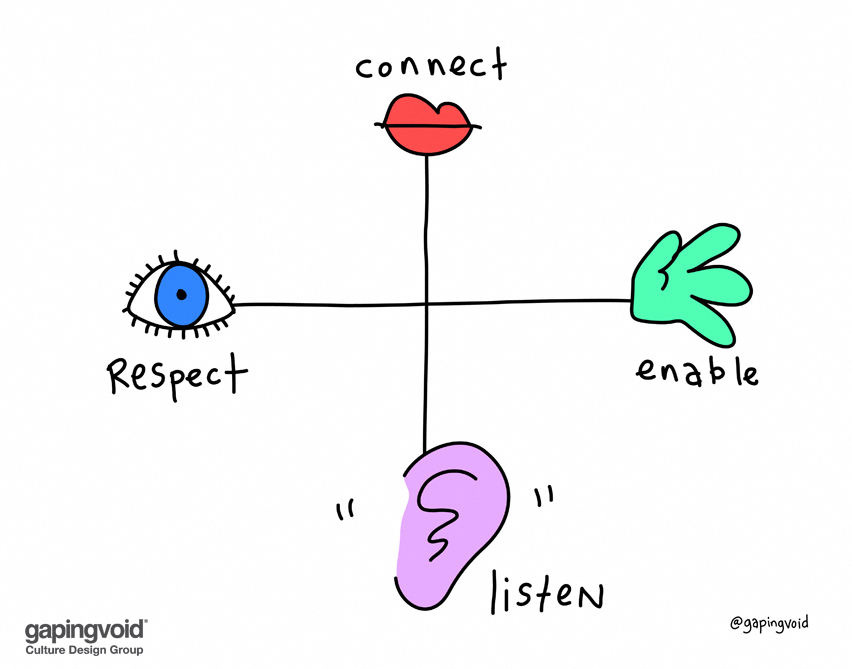
Here's pretty much everything you need to know about being a good leader -- whether you are the CEO of a Fortune 500 company or the Director of a 5-person non-profit. Ready?
Connect: If you want to lead people, you will need to begin by connecting with them, as in develop some kind of trusting relationship. No one is going to follow a leader they haven't bonded with. You may get compliance. You may even get cooperation. But you won't get commitment. What can you do to more powerfully connect with the people you are working with?
Enable: The key to being a successful leader is finding a way to empower the people who have been attracted to your business or project. If people are intrinsically motivated and have room to move, they will create magic. If not, they will merely go through the motions. How can you enable the people you are working with to be self-starting and inspired to give their best?
Listen You might be the leader, but that does not mean that you know everything. Indeed, you will need to learn a lot if you expect to succeed in your leadership role. The simplest way to learn is to listen. Identify the people who know something you don't and listen to them. And, even if you think you know more than others, listen anyway. If people are going to give their best, they need to know that someone is listening. And that someone is you. What can you do, this week, to become a better listener?
Respect: No matter what role anyone in your organization or volunteer group is playing, they are a human being first. And human beings have a gigantic need to be respected. Not just for what they do, but for who they are... and how they feel... and what ideas they are bringing to the table. In what ways can you express your respect for the people you are leading? Cue Aretha Franklin.
Illustration: gapingvoid
Idea Champions
One of our leadership trainings
Our Innovation Reality Check service
Posted by Mitch Ditkoff at 10:24 AM | Comments (0)
October 28, 2017Innovation from the Inside Out

These days, almost all of Idea Champions' clients are talking about the need to establish a culture of innovation. Some, I'm happy to report, are actually doing something about it. Hallelujah! They are taking bold steps forward to turn theory into action.
The challenge for them is the same as it's always been -- to find a simple, authentic way to address the challenge from the inside out -- to water the root of the tree, not just the branches.
External systems and protocols, no matter how seductive they are to create, are simply not sufficient to guarantee real innovation. In the words of Oliver Wendell Holmes, "Systems die. Instinct remains."
This is not to say that organizations should ignore systems and structures in their effort to establish a culture of innovation. They shouldn't. But systems and structures all too often become the Holy Grail -- much in the same way that Six Sigma has become the Holy Grail.
Unfortunately, when the addiction to systems and structures rules the day, an organization's quest for a culture of innovation degenerates into nothing much more than a cult of innovation.

Organizations do not innovate. People innovate. Inspired people. Fascinated people. Creative people. Committed people. That's where innovation originates -- from deep within the inspired individual who understands that his/her sustained effort is what's required to go beyond the status quo.
The organization's role -- just like the individual manager's role -- is to get out of the way. And while this "getting out of the way" will undoubtedly include the effort to formulate supportive systems, processes, and protocols, it is important to remember that systems, processes, and protocols are never the answer. They are the context, not the content. They are the husk, not kernel. They are the menu, not the meal.
Ultimately, organizations are faced with the same challenge that religions are faced with. Religious leaders may speak passionately about the virtues their congregation needs to abide by, but sermons only name the challenge and remind people to experience something -- they don't necessarily change behavior.
Change comes from within the heart and mind of each individual. It cannot be legislated or evangelized into reality.
What's needed in organizations who aspire to innovation is an inner change. People need to experience something within themselves that will spark and sustain their effort to innovate -- and when they experience this "something," they will be self-sustaining.
They will think about their projects in the shower, in their car, and in their dreams. They will need very little "management" from the outside. Inside out will rule the day -- not outside in. Intrinsic motivation will flourish.
People will innovate not because they are told to, but because they want to. You can create all the reward systems you want. You can reinvent your work space until you're blue in the face. You can license the latest and greatest idea management tool, but unless each person in your organization OWNS the need to innovate and finds a way to tap into their own innate brilliance, all you'll end up with is a mixed bag of systems, processes, and protocols -- the husk, not the kernel -- the innovation flotsam and jetsam that the next administration or next CEO or next key stakeholder will mock, reject or change at the drop of a hat if the ROI doesn't show up in the next 20 minutes.
You want culture change? You want a culture of innovation?
Great. Then find a way to help each and every person in your organization come from the inside out. Deeply consider how you can nurture, and develop the primal need all people have to create something extraordinary.
What is the simplest thing you can do, today, to spark innovation on your team?
Posted by Mitch Ditkoff at 10:58 AM | Comments (10)
October 12, 2017What It Really Means to Be a Chief Innovation Officer

Some sound advice here, from the Harvard Business Review, on what it takes to be a successful Chief Innovation Officer.
Idea Champions
A workshop for innovation leaders
The Current Reality Check Up
Posted by Mitch Ditkoff at 10:35 PM | Comments (0)
March 24, 2017Free Online Innovation and Creativity Summit 2017
Here's Nick Skillicorn introducing the upcoming, online Innovation and Creativity Summit 2017. I am happy to announce that I will be one of the 45 presenters. My topic? The power of storytelling to spark innovation. Cost? Zero. Zippo. Zilch. Click here to register. Summit begins on April 2.
MitchDitkoff.com
Storytelling at Work
Posted by Mitch Ditkoff at 10:53 AM | Comments (0)
February 20, 2017Unresolved Conflict at the Top Produces Chaos in the Middle and the Bottom

A guest post by Idea Champions' newest leadership development consultant, Dr. Barry Gruenberg.
When those in senior leadership positions avoid conflict among themselves, the unresolved conflict ripples throughout the organization and paralyzes action at every level. Key issues go unresolved and the tension at the top pervades the organization. Followers of each of the powerful protagonists must constantly demonstrate their loyalty to their sponsors in their words and deeds; they must scrutinize all that they do to ensure that they are not seen as violating the party line.
Lower level employees are often enlisted to participate in task forces or committees to deal with the various by-products of the unresolved issues.
These efforts are virtually guaranteed to fail since any recommendations for resolution will compromise at least one of the contending senior managers who will usually use their power to veto the idea, leaving the task force frustrated and progress hindered.

This is ironic because the members of the task force will have attempted to remain loyal to their constituency throughout the proceedings and will usually feel that they have salvaged the most important interests of their group in the negotiation process. But the senior managers, who have delegated their conflict, will generally take an all or nothing posture on the outcome.
The only true resolution to this phenomenon requires the direct participation of the protagonists -- their committed effort to resolve their differences before the symptoms of their misalignment irrevocably muddies the organizational waters.
Idea Champions
Becoming an Adaptive Leader
Listening With Impact
Posted by Mitch Ditkoff at 09:07 AM | Comments (0)
February 01, 2017My Open Letter to Donald Trump Published in the Huffington Post

My open letter to Donald Trump has just been published in the Huffington Post -- my attempt to light a candle instead of cursing the darkness. If you resonate with what I've written, please forward it to friends and post on social media. Thanks! Mitch
Posted by Mitch Ditkoff at 05:20 PM | Comments (0)
January 26, 2016Story as a Leadership Tool
Here's a lovely animated intro to why STORYTELLING is such a powerful communication and business tool -- by the author of Circle of the 9 Muses.
Storytelling at Work
More useful links about storytelling
And more
Posted by Mitch Ditkoff at 06:44 PM | Comments (0)
January 12, 2016How Storytelling Shapes Culture and Humanizes the Workplace

More goes on in the modern-day workplace than meets the eye. Indeed, it's often the stuff that meets the ear that makes all the difference. Click here to listen to Mitch Ditkoff's 60-minute VoiceAmerica interview on the power of personal storytelling in the workplace.
THE BOOK: Storytelling at Work
THE KEYNOTE: Storytelling at Work
THE BLOG: Storytelling at Work
Posted by Mitch Ditkoff at 01:50 AM | Comments (2)
September 15, 2015The Art of Sparking Innovation
When my mother was alive, she told me she had no idea what I did for a living. Around the canasta table, she would tell her friends I was a "motivational speaker", no matter how many times I explained what I actually did. The slide show below is dedicated to her and to YOU, too -- especially if you're wondering what the heck goes on in one of Idea Champions' innovation-sparking workshops. Best to view full screen.
Posted by Mitch Ditkoff at 05:18 PM | Comments (0)
July 17, 2015A Creative Tip from Einstein

One way to do so
Idea Champions
We talk our walk
Brainstorm Facilitation Training
Posted by Mitch Ditkoff at 04:30 PM | Comments (0)
May 01, 2015The Professor and the Jar

A college professor stood before his philosophy class at the start of a new semester. Silently, he picked up a very large jar and filled it with golf balls. Then he asked the students if the jar was full. They agreed that it was.
The professor then picked up a box of pebbles and poured them into the jar. He shook the jar lightly, pebbles settling into the open areas between the golf balls. He then asked the students again if the jar was full.
They agreed that it was.
The professor next picked up a box of sand and poured it into the jar. He asked once more if the jar was full. The students again responded with a resounding "yes."
The professor then produced two cups of tea from under the table and poured them into the jar, filling the empty spaces between the sand. The students laughed.
"Now," said the professor. "I want you to understand that this jar represents your life. The golf balls are the important things -- your family, health, friends, and feeling of well-being. If everything else was lost and only they remained, your life would still be full."
"The pebbles are the other things that matter -- your job, your house, your accomplishments etc. The sand is everything else -- the small stuff."
"If you put the sand into the jar first," he continued, "there's no room left for the golf balls or pebbles. The same holds true for life. If you spend all your time and energy on the small stuff, you'll never have room for the things that are really important to you."
"Pay attention to the things that are essential to your happiness. Spend time with your children. Spend time with your parents. Take your spouse out to dinner. Smell the flowers. Enjoy the beauty of existence. There will always be time to clean the house and fix the disposal. Take care of the golf balls first -- the things that really matter. The rest is just sand."
One of the students then raised her hand and asked what the two cups of tea were about
The professor smiled, "I'm glad you asked."
"The tea shows you that, no matter how full your life may seem, there's always room for tea with a friend."
This story is not in my forthcoming book, but 36 others are.
Idea Champions
Posted by Mitch Ditkoff at 09:36 AM | Comments (1)
January 24, 2015Radio Woodstock in the House!

We just received this very nice piece of feedback from the President of Radio Woodstock, Gary Chetkof.
"Idea Champions was a true partner in helping us untangle some of the issues we were struggling with. They were very easy to work with and the processes used were fun and creative and they worked splendidly. We were able to find out what the major obstacles were and our entire team worked together to find solutions. Everyone participated fully, and everyone now has much more clarity about how to better work together. We even have our new mission statement that you can see on our Facebook page! I wholeheartedly recommend Idea Champions to any business that wants to problem solve, brainstorm, or get their employees to work more harmoniously together."
Our teambuilding offerings
Yes, Idea Champions is based in Woodstock!
And this just in from Richard Fusco, Radio Woodstock's General Manager:
"As a small company where everyone wears many hats, being organized and all pulling in the same direction is key. Strangely, as a communications company, our internal communications were off. Val Vadeboncoeur of Idea Champions helped us with all three. His sessions were focused and fun. We all came away with a new unified working spirit."
Posted by Mitch Ditkoff at 11:34 AM | Comments (0)
September 15, 2014Is Peace the Innovation We Need the Most?

"Innovation" continues to be a hot topic in corporate circles these days -- a "competitive edge" organizations are increasingly attempting to hone so they can not only differentiate themselves from the competition, but survive in today's topsy turvy economy.
That being said, there are some forward thinking organizations out there who are going beyond the status quo and seriously asking themselves what they can do differently to not only be "socially responsible", but use their corporate clout to help various peace-themed global causes truly impact positive change.
If that describes your organization, please contact us. Idea Champions, in 2015, will be launching a new innovation-sparking service to help corporations, world wide, figure out HOW they can leverage their resources, bandwidth, and brainpower to foster peace and well-being in the world -- and still make a profit.
International Day of Peace in the Huffington Post
Idea Champions
Posted by Mitch Ditkoff at 02:35 PM | Comments (0)
September 01, 2014REAL ROI: Return on Imagination!
If you're a champion of innovation, chances are good you've encountered the ROI beast more than a few times -- senior leaders looking at you cross-eyed and questioning the value of your efforts. Stop the madness! Change the game! Forward this slide show today!
First, get clear about your problemPosted by Mitch Ditkoff at 11:26 AM | Comments (1)
March 29, 201456 Reasons Why Most Corporate Innovation Initiatives Fail

Innovation is in these days. The word is on the lips of every CEO, CFO, CIO, and anyone else with a three-letter acronym after their name. As a result, many organizations are launching all kinds of "innovation initiatives" -- hoping to stir the creative soup. This is commendable. But it is also, all too often, a disappointing experience.
Innovation initiatives sound good, but usually don't live up to expectations. The reasons are many. What follows are 56 of the most common -- organizational obstacles we've observed that get in the way of a company truly raising the bar for innovation.
See which ones are familiar to YOU. Then, sit down with your Senior Team... CEO... innovation committee, or team and jump start the process of going beyond these obstacles.
56 Reasons Why Most Corporate Innovation Initiatives Fail
1. "Innovation" framed as an initiative, not the normal way of doing business
2. Absence of a clear definition of what "innovation" really means
3. Innovation not linked to company's existing vision or strategy
4. No sense of urgency
5. Workforce is suffering from "initiative fatigue"
6. CEO does not fully embrace the effort
7. No compelling vision or reason to innovate
8. Senior Team not aligned
9. Key players don't have the time to focus on innovation
10.Innovation champions are not empowered
11. Decision making processes are non-existent or fuzzy
12. Lack of trust
13. Risk averse culture
14. Overemphasis on cost cutting or incremental improvement
15. Workforce ruled by past assumptions and old mental models
16. No process in place for funding new projects
17. Not enough pilot programs in motion
18. Senior Team not walking the talk
19. No company-wide process for managing ideas
20. Too many turf wars. Too many silos.
21. Analysis paralysis
22. Reluctance to cannibalize existing products and services
23. NIH (not invented here) syndrome
24. Funky channels of communication
25. No intrinsic motivation to innovate
26. Unclear gates for evaluating progress
27. Mind numbing bureaucracy
28. Unclear idea pitching processes
29. Lack of clearly defined innovation metrics
30. No accountability for results
31. No way to celebrate quick wins
32. Poorly facilitated meetings
33. No training to unleash individual or team creativity
34. Voo doo evaluation of ideas
35. Inadequate sharing of best practices
36. Lack of teamwork and collaboration
37. Unclear strategy for sustaining the effort
38. Innovation Teams meet too infrequently
39. Middle managers not on board
40. Ineffective roll out of the effort to the workforce
41. Lack of tools and techniques to help people generate new ideas
42. Innovation initiative perceived as another "flavor of the month"
43. Individuals don't understand how to be a part of the effort
44. Diverse inputs or conflicting opinions not honored
45. Imbalance of left-brain and right brain thinking
46. Low morale
47. Over-reliance on technology
48. Failure to secure sustained funding
49. Unrealistic time frames
50. Failure to consider issues associated with scaling up
51. Inability to attract talent to risky new ventures
52. Failure to consider commercialization issues
53. No rewards or recognition program in place
54. No processes in place to get fast feedback
55. Inadequate sense of what your customers really want or need
56. Company hiring process screens out potential innovators
Posted by Mitch Ditkoff at 01:31 PM | Comments (4)
March 07, 2014Your Money or Your Life

For the life of me, I cannot remember the name of the financial services company that left me an urgent voice mail message asking that I call them back immediately about my availability to lead their annual leadership retreat on a island off the coast of Florida.
All I can recall was how generic sounding their name was -- something like National Investment Services... or Consolidated Financial Brokers.... or The American Banking Alliance -- kind of like the corporate equivalent of John Doe.
Somehow, they had heard of me and, with their big company pow wow coming up, were looking for someone, with a track record, to help them "become more innovative."
Never having heard of them before, I googled their name and, 1.73 seconds later, found myself on their website, slickly designed, I imagined, by someone with a special fondness for iStock photos of earnest looking models impersonating business people -- models who must have just moved to L.A. to pursue acting careers, but found themselves, at 24 or 35, working part-time as waiters and jumping at the chance to pick up some easy money wearing a suit and a smile for a day.

Easy for me to say -- me being the proverbial pot calling the proverbial kettle black with my big ass mortgage, family to feed and young entrepreneur's dream of making it big so I'd actually have enough moolah, one day, to invest with a financial services firm. Not to mention all the time in the world to write my best-selling book.
My first meeting with the client was pleasant enough. They talked. I listened, choosing not to interrupt them every time they made their point with an acronym I probably should have known if I only I hadn't spent my formative years living as a hippie, poet and monk.
OK, so they weren't a solar energy company. So they weren't asking me to help them end AIDS. I got it. This was business. The money business. The big money business -- and I was in it, no matter how much Rilke and Rumi I read on the side. Money. This was about money. Money and the VP of something or other inviting me to meet with him and his team the following week on the 57th floor of a building on Wall Street. There would be a badge waiting for me at the security desk, he explained. All I needed to do was show my ID.
Thrilled? Was I thrilled? Not exactly. But this was a possible gig and I needed the bread, so I went.
The VP and his team on the 57th floor looked nothing like the iStock photos on their company's homepage, though they did have a real nice view of Manhattan and a large mahogany conference table.
Our conversation went well enough. I asked all the right questions. They gave all the right answers. They sprinkled the conversation with football metaphors. I nodded. They gave me their business cards. I gave them mine. But on the way home, I began to feel a creeping sense of dislocation and dread -- like I was auditioning for a movie I wasn't quite sure I wanted to be in -- a movie being produced by a very fat man, sitting poolside, cell phone and martini in hand.

So when they called me back for a third meeting, I was betwixt and between. Do I simply trust my instincts and tell them I'm not their man? Or do I let go of my all-too-obvious self-righteous judgments and focus on the possibility that I might actually be able to help them get to higher ground?
Eternally the optimist, I chose the latter and decided to meet with them a third time -- a meeting, sad to say, which only confirmed the fact that I didn't like them very much and didn't like myself for sitting in a room with them and enabling their collective hallucination of themselves as a service organization when all they really wanted to do was make more money. Lots more money.
More chit chat. More coffee. More "run it up the flagpole" platitudes that littered our conversation like hidden charges on a credit card bill.
This was the moment of truth.
My client-to-be, apparently satisfied with what was about to become his decision to engage my services, cut to the chase and asked me to quote him a fee.
The honorable thing to have done, at the time, would have sounded like "John, I wish you the best of luck at your offsite, but after deep consideration, I don't think I'm the best possible fit for your company's needs."
But since I hadn't yet mastered the art of speaking my truth I took the easy way out and doubled my fees, thinking that they would now be so ridiculously high it would be the client's decision to end the relationship, not mine.
"That sounds about right," the client exclaimed, extending his right hand to seal the deal.
Fast forward six weeks later.
It's 8:30 a.m. and I'm on stage, in the Oakwood Room, on a beautiful island off the coast of Florida. Looking out at the audience, I notice that four of the gathered troops are sleeping, heads on the table. Someone in the front row explains to me that last night had been a "late one" and they'd all stayed up, drinking, until 4:00 a.m.

I tap the mic and begin speaking, trusting that the sound of my amplified voice would be enough to wake the dead.
Two of them snap to attention. The other two don't, still lightly snoring.
I signal the people sitting next to their sleep-deprived peers to poke them, which they do, shooting glances at me as if I am a substitute algebra teacher.
This is, as far I could tell, not a leadership offsite at all, but a college fraternity weekend -- big men on campus with stock options, golf shirts and a very high opinion of themselves. The collective attention span in the room is somewhere between a tse tse fly and a lizard. Nothing I say lands. Nothing. Nada. Zilch. Only one thing is clear -- I am the highly paid warm up act before another night of drinking -- a small typographic box they can check off next quarter to prove they have done "the innovation thing."
I may have missed the moment of truth back at my client's office six weeks ago, but I wasn't going to miss it today.
"Gentlemen and ladies," I announce. "It's obvious that some of you don't want to be here. It seems you'd rather be golfing, napping or checking your email. I have no problem with that. So... we're going to take a 20-minute break. Only return if you really want to be here. Otherwise, you'll just be dead weight, screwing it up for the rest of us. Kapish?"
Twenty minutes pass. Everyone returns. Every single one of them.
And while the rest of the day didn't exactly qualify as one of the great moments in the history of innovative leadership off sites, at least it wasn't a total loss. Some good stuff actually happened. People woke up. People shaped up. People stepped up. And I learned a valuable lesson that would serve me for the rest of my life: Follow my feeling, not the money trail.
This story excerpted from my forthcoming book: WISDOM AT WORK: How Moments of Truth on the Job Reveal the Real Business of Life.
This story also in the Huffington Post
What's the Problem?
How to help these guys change
We all have a story to tell
Idea Champions
Posted by Mitch Ditkoff at 11:28 AM | Comments (0)
February 19, 2014How to Open the Door to Innovation

There is no magic pill, but there is a key. And the key has a lot to do with creating a critical mass of savvy innovation catalysts and change agents who know how to open doors (and minds).
Posted by Mitch Ditkoff at 08:32 PM | Comments (0)
February 17, 2014Would You Invest Three Hours to Save Yourself Months of Wasted Effort?

Idea Champions has just launched a groundbreaking three-hour workshop that will save your organization untold time, tons of money, and a thousand pounding headaches you can't afford to have.
Posted by Mitch Ditkoff at 02:18 PM | Comments (0)
February 15, 2014How to Help Your Senior Team Get Aligned About a Strategic Direction

I am totally inspired by the feedback that Steven McHugh, co-Founder and Chief Innovation Officer of Idea Champions, received from Life Care Centers of America, in response to a two-day Senior Team Strategy Offsite he designed and facilitated for them. See below...
 "I wanted to thank you for the wonderful work you've done for us at Life Care Centers of America.
"I wanted to thank you for the wonderful work you've done for us at Life Care Centers of America.
As you know, when I left my CFO position at Olin Corporation to help lead Life Care, I was presented with a number of difficult challenges. Due to strict government regulations, the long-term care industry was in turmoil. In 30 years, Life Care had not performed any unified, long-term strategic planning, and there was no HR department for over 27,000 employees.
Based on the excellent work you did for over five years with my former company, I knew you had the skills to help us. Your role in aligning 230 different facilities into a unified force has been remarkable, especially in the short time frame you were given.
As you know, the results of the process you took us through have been astounding. In an environment where five of the top six public nursing home companies have declared bankruptcy, we have enjoyed unprecedented growth. You helped our senior officers transform into a dynamic leadership team. Our clarity around an aligned mission translated into a powerful vision that we can communicate to the rest of the organization.
Your Vision Mapping sessions were the catalysts for communicating our message to the rest of the organization. Your ability to develop balanced scorecards for all 230 facilities was the key to translating strategy into results.
It is now clear what actions are important for us to take, and for the first time, our people know how their success will be measured.
From the senior level to the staff in each facility, actions are now aligned to achieve strategic goals.

As an interesting byproduct of your work here, we are beginning to develop leaders at all levels in the organization who are empowered to do whatever it takes to get the job done. They have a clear line of sight to the strategic goals and are stepping up to the plate to get them done.
I am proud of how we have responded to the process you have embedded into our culture. Thank you for justifying my faith in bringing you in to facilitate this major change in how we operate.
I look forward to continuing our work together in developing a high performance organization."
-- Michael Waddell, President, Life Care Centers of America
50 quotes on possibility
50 quotes on vision
Creators on Creating
What we do
Idea Champions
Posted by Mitch Ditkoff at 01:26 PM | Comments (0)
January 17, 2014What Business Can Learn from Baseball

A few years ago I ran across an article that got me thinking about how what we measure can change the way we think about what we measure, and how the latest technology that enables us to measure more and more things is not always our friend.
For several decades now, baseball scouts and coaches have been using radar guns to measure how hard pitchers throw. In fact, you can always spot a scout at a baseball game because he's the guy in the stands, behind home plate, with the radar gun pointed at the pitcher, zealously jotting down little nuggets of facts in his notebook like a squirrel gathering acorns.
Not surprisingly, baseball people have come to value pitchers who can throw hard (95 MPH and faster).

This seems to make sense at face value, but if we think about it a bit more we have to ask ourselves if throwing a baseball faster actually makes one a better pitcher. The answer is -- not necessarily.
There are many factors that contribute to making a pitcher effective:
1. Does the pitcher throw the ball exactly where he wants to throw it?
2. Is it easy or difficult for the batter to see the ball coming out of the pitcher's hand?
3. Can the pitcher throw his array of pitches at different speeds, confusing the batter's timing?
4) Can the pitcher deal with adversity, or does he get rattled when things go wrong?
These factors are all more important than how hard a pitcher throws a baseball.
But baseball's obsession with pitch speed, enabled by the ease of measuring speed with a radar gun, has caused some organizations to lose focus on what they're really trying to gauge; that is, the pitcher's effectiveness -- can he get batters out?
A few years ago, the Kansas City Royals conducted an experiment to test the existing assumption that faster is better.
Dayton Moore, the General Manager of the Kansas City Royals, has issued an edict banning radar guns from the lower levels of the organization -- the place where young players first go to develop their skills.
Moore believed that eliminating radar guns from the minor leagues would eliminate a big distraction for young pitchers -- getting caught up in throwing hard in order to be noticed and promoted and forgetting to develop other, key pitching skills.
It may take some time to determine if Moore's hunches turn out to be right, but I, and a host of soft-throwing pitchers in the Baseball Hall of Fame, like Whitey Ford and Hoyt Wilhelm, are willing to bet that they are.
I will end my baseball rant with the following quote from the contemporary economist. Adam Smith:
"Some years ago the sociologist and pollster, Daniel Yankelovich, described a process he called the "McNamara Fallacy", named after the Secretary of Defense, Robert McNamara, who had so carefully quantified the Vietnam War.
'The first step,' he said, 'is to measure what can easily be measured. The second is to disregard what can't be measured, or give it an arbitrary quantitative value. This is artificial and misleading. The third step is to presume that what can't be measured easily isn't very important. This is blindness. The fourth step is to say that what can't be easily measured really doesn't exist.'
The philosopher A. N. Whitehead called this tendency, the Fallacy of Misplaced Concreteness.
Are contemporary business and government leaders all too quickly and lazily falling into the trap of McNamara's Fallacy? Are we measuring only that which is easy to measure (and money, for one thing, is easy to measure) and making decisions based merely on those numbers because other important factors, such as long-term effects on quality of life and the environment, are just too difficult to quantify?
Should we all be rethinking what we measure and why, just like the Kansas City Royals did? And what are our own industry's "radar gun measurements" that give us easy-to-acquire numbers that gather importance simply because they're easy to get?
And if you're still not convinced, consider what Albert Einstein had to say about the topic: "Not everything that counts can be counted and not everything that can be counted counts!"
-- Val Vadeboncoeur
Idea Champions
The author of this article teaches this course
Posted by Val Vadeboncoeur at 02:43 PM | Comments (1)
November 02, 2013Wake Up the Passion to Innovate

Innovation is a big fat generic concept in most corporations -- like life on other planets or trying to get teenagers to clean up their room.
Unless the individuals within an organization have a genuine sense of urgency, personal ownership, and an authentic passion for innovation, nothing much will happen.
Corporate initiatives that fail to awaken the human instinct to innovate are doomed, no matter how many pep talks, tote bags, or t-shirts proliferate.
For me, as an innovation consultant, it is clear that the short amount of time I have with my clients needs to be devoted to awakening the passion to innovate.
Tools, techniques, theory, data, models, bibliographies, business cases, best practices, and the fabulous muffins served on breaks are all fine, but it is the passion to innovate that is the real driver of success.
No passion, no innovation. Plain and simple.
Unfortunately, most organizations squash passion. That is why start-ups have a much easier time innovating than Fortune 500 companies. And that's why savvy Fortune 500 companies recreate the feeling of start-uppiness whenever they can.
The best thing any consultant can do when working with an organization is to hold up a mirror and ask their clients what they see.
Are they modeling what it means to be innovative? Or are they asking other people to do what they themselves have not done?
Idea Champions
Applied Innovation
Short videos of me
Posted by Mitch Ditkoff at 01:17 AM | Comments (0)
October 22, 2013WOBI: Big Visions, Little Strokes and Everything in Between

The Heart of Innovation is happy to publish the following guest post from Lynnea Brinkerhoff, Idea Champions' Empress of Organizational Development, reporting on the June, 2013 WOBI conference in New York City.
Lobby crawling at the World Business Forum (WOBI) in the famed Radio City Music Hall amid thousands of clean-cut global corporate sophisticates, I feel a strange remembrance of the world that launched me.
While suit cuts and hair styles have been updated, many of the ideas have not. I find this both comforting and strangely disquieting.
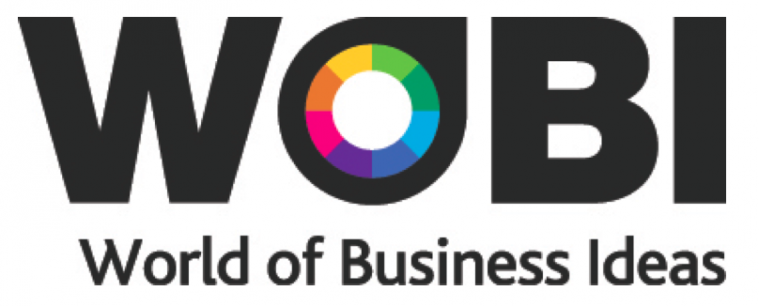
Egged on by former Governor Jeb Bush and the offbeat authors of best-seller, Freakonomics, the audience is encouraged to lose its love affair with its own barriers to breakthrough.
Four thousand world business leaders sit at seeming attention as we are reminded, again and again, through parable, to embrace radical solutions during these times of massive disruption.
We are called to progress, to have courage, to transform our organizations beyond what we think is possible -- called by Carlos Brito, CEO of Anheuser Busch to maximize performance and culture, functionality and elegance -- to attempt what we are not sure we can do.
Nancy Koehn, of Harvard. offers a historical view of leadership and highlights a story about the perilous, ultimately victorious journey of Edgar Shackleton, told in exquisite detail and infused with undeniable lessons for every leader in the room.
She reminds us that, once the mission is clear and embraced, once resources are secured and the gaze of glory is fixed on the future, giving up is not an option.
One of my perennial favorites, Winston Churchill, would certainly have agreed -- that, when records are broken, unchartered territory discovered, and national pride gained, we must follow his simple edict, proceed. While touted as viable journeys, however, they are not the only ones worth making.
Ben Franklin said it best (unfortunately, he did not make an in-person keynote at WOBI this year). "Little strokes fell big oaks."
These are the two sides of the coin these days. We need massive, BHAGS (big, hairy, audacious goals) focused on blue sky thinking AND we need people willing to make small changes -- eyes open to what is being called for, moment-to-moment, on the ground. 
We need people who can take bold action amidst the kind of disruptive future that Alec Ross, media and technology director for the Obama campaign, declares is coming our way AND we need people making stealth interventions to help sustain a gentle momentum in a positive direction over a long period of time.
Progress or protect? Transform or continue? Courage or caution?
The only answer to these seeming polarities, explains thought leader Barry Johnson, is YES, beseeching us to find a creative way to seek something beyond EITHER/OR --- the lens we usually look though to examine yesterday's problems -- assuming that only one answer rules.
It doesn't.
Claudio Fernandez Araoz, global talent specialist. reminds us just how far past those days are past with one mind jamming sentence: "In such times as these, even the past is uncertain."
Ubiquitously discussed at WOBI is the vital need for today's leaders to exercise the forbearance of cultural icons and unsung heroes -- leaders like Abraham Lincoln who persevered through unprecedented losses, depression and doubt. Obama today exercises this quality amid unthinkable complexity.
Jack Welsh, a man not necessarily known for his forbearance, reminded us to lead with the generosity gene and show gratitude for those who serve our mission -- though he still narrowly refers to winning as the only point of business.
One thing I found missing from two-day WOBI conference was the unspoken impact of global business on the environment.
If we only get what we measure, as Jack never ceases to remind us, then the imperative to regenerate the natural places that nourish us as we extract commodities to add to life's conveniences seems germane.
Means do not always justify the ends.
It seems to me that only resilient, thoughtful, broadly considered decisions made by stakeholders in a well-choreographed, trust-infused dialogue, does justice to means and ends.
It's as close as we can get these days to a solution that honors the complexity of our modern day dilemmas, or VUCA as the military specialists like to call it: Volatility, Uncertainty, Chaos, and Ambiguity
Measurement? Why not measure that which makes for a better life?
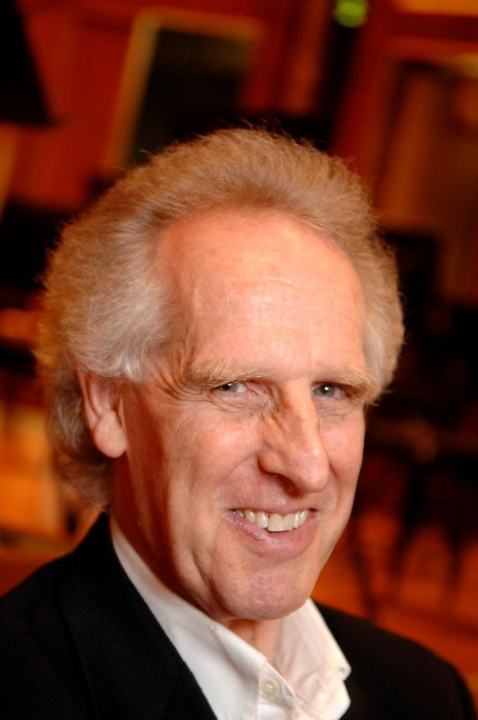
The piece de resistance of the conference? Maestro-Mensch of the 21st Century, Ben Zander, as hands on as it gets (the keyboard of a piano!), who turned us all onto our own muses -- and the inspiration at the root of all creative ventures.
"Who am I being that the eyes of my employees are shining... or not?" he asked us, explaining that his job, as the conductor of an orchestra for the last 37 years, has been to "remind the players of the rhythm of transformation and to remove obstacles to their playing their best sound".
Reminding us that we always have three choices -- resignation, anger or possibility -- Zander invited the rapt audience to chose the third.
We can resign when we die. For now, life is for the living and leadership's job is to ensure further life by cultivating sustained health in the organizations and ecosystems in which we serve.
Disruption or not, the way through all of the ambiguity before us is the daily recommitment to polishing our best selves and surrounding ourselves with those who are aspiring to the same kind of excellence.
And that is the task WOBI has taken on -- reminding senior leaders to be worthy examples of the very best of what it means to authentically lead during these times of radical change, dislocation, and opportunity.
A big THANK YOU to Fallon Prinzivalli for inviting us to the WOBI conference. Much appreciated.
Posted by Mitch Ditkoff at 09:51 AM | Comments (0)
October 15, 2013Go Beyond the Impostor Syndrome

In a rapidly changing, highly complex and unpredictable world, leadership has little to do with being the smartest person in the room.
It is often the case that those holding positions of authority believe they must justify their position by providing the best solutions to the problems they face.
Often this need to demonstrate that one "has the answer" is grounded in a deeply rooted fear that one, in fact, does not truly know what to do and that revealing one's uncertainty will lead to an erosion of confidence in one's superiors and subordinates.
They see their authority as grounded in their knowledge and expertise and feel obliged to demonstrate their acumen whenever consequential problems are addressed.
This phenomenon invariably leads to compensatory behavior in which one's inner doubts and uncertainty about how to address complex and ambiguous issues leads to unjustified rigidity of positions and an inability to see the value of alternative points of view.

If we must constantly prove to everyone that we deserve the position we have attained, we can never allow ourselves to be seen as needing to learn anything or to rely on anyone else.
This dilemma -- often referred to as the "impostor syndrome", -- systematically undermines one's ability to learn, to benefit from the perspectives of others, and to appreciate the value of others' strengths and points of view.
It also often leads to behaviors in which we diminish others in order to reassure ourselves of our importance and our value.
Lastly, it virtually guarantees that the decisions that get made are not the best ones because they are not informed by the experience, insight, and creativity of the people around us.
- Barry Gruenberg
Idea Champions
34 Awesome Quotes on Leadership
Posted by Mitch Ditkoff at 01:50 AM | Comments (2)
March 27, 2013Infusing Your Workplace with Humanity
62% of all Americans are dissatisfied with their work. 85% of the general public don't trust business leaders to tell the truth when confronted with difficult issues. If YOUR organization wants to explore practical ways of raising the quality of the workplace experience and engaging employees in ways that are humane and sustainable, here's your starter kit. You may also be interested in our Humanizing the Workplace keynotes, town meetings, and workshops.
Posted by Mitch Ditkoff at 10:33 AM | Comments (0)
March 21, 2013The Humanize the Workplace Poll
If you work for an organization that needs to become a more benevolent and humane workplace, I invite you to respond to Idea Champions' new Humanizing the Workplace poll.
Not only will it jump start your thinking about simple changes that can be made on the job, it will also provide us with the vital input we need to really tune into the issues.
You'll need about five minutes.
We'll be posting the results of the poll here in a few weeks, but if you'd like us to email the results to you directly, just note your email address in the comments box or send a message to info@ideachampions.com
You can read more about this topic in my latest Huffington Post article.
Posted by Mitch Ditkoff at 08:15 AM | Comments (0)
March 20, 2013How to Humanize the Workplace
A recent poll has revealed that 62% of Americans are dissatisified with their work.
While there are a lot of contributing factors, one BIG factor is that most workplace environments are not wired to bring out the best in people. Quite the contrary.
That's what my newly published article in the Huffington Post is all about.
It doesn't just name the problem, however. It also provides a simple "starter kit" for how each and everyone of us can begin to humanize our workplace environments.
Click here to weigh in on the topic by responding to my Humanizing the Workplace poll. If you want to register for my April 4th Telesummit on this topic, click here. It's free.
Idea Champions
Posted by Mitch Ditkoff at 12:32 PM | Comments (0)
December 13, 2012What's Next After Twitter
This just in! Twitter is dead.
Or if not dead, dying. Or if not dying, passe. It's time has come and gone.
Industry experts agree. There is now a way more streamlined option available to you. Find out here -- noted in my most recent Huffington Post article.
12/12 is the Pope's first day on Twitter.
Idea Champions
Posted by Mitch Ditkoff at 12:07 PM | Comments (0)
October 25, 2012The Kindness-At-Work Manifesto
This just in! We're here for just a little while. No one gets out of here alive. Not even Donald Trump. So while you're here, remember to be kind and go beyond judgment, blame, and impatience -- especially when things start getting stressed out. Like on-the-job.
Here's my inspired rant on the subject, just published in The Huffington Post.
Posted by Mitch Ditkoff at 11:38 PM | Comments (0)
July 17, 2012Rethinking The Role of a Manager
The root of the word "manager" comes from the same root as the words "manipulate" and "maneuver", meaning to "adapt or change something to suit one's purpose". Although these words may carry a pejorative meaning, there is nothing inherently wrong with them. Indeed, into each life a little manipulation and maneuvering must fall.
For example, if the door to your office gets stuck, a handyman might need to manipulate it to get it working again. If there is a log jam at the elevator, you might decide to maneuver around the crowd and take the stairs.
However, there is another kind of manipulation and maneuvering that is a problem -- when managers use their position to bend subordinates to their will.
While short-term gains may result, in the end the heart is taken out of people. Your staff may become good soldiers, but they will lose something far more important in the process -- their ability to think for themselves.
Unfortunately, ingenuity in many corporations has gone the way of the hula-hoop. "Intellectual capital" is the name of the game these days -- and it is the enlightened manager's duty to learn how to play. Only those companies will succeed whose people are empowered to think for themselves and respond creatively to the relentless change going on all around them.
Managers must make the shift from manipulators to manifesters. They must learn how to coach their people into increasingly higher states of creative thinking and creative doing. They must realize that the root of their organization's problem is not the economy, cycle time, strategy or outsourcing, but their own inability to tap into the power of their workforce's innate creativity.
Where does this empowerment start? First, by recognizing what power is: "the ability to do or act". And second, by realizing that power is intimately connected to ideas.
Most managers, unfortunately, perceive new ideas as problems -- especially if the ideas are not their own. More often than not, managers don't pay enough attention to the ideas of the people around them. They say they want innovation. They say they want "their people" to do something different. But they do precious little to support their subordinates in their efforts to do so. More commonly, they foist their own ideas on others and can't figure out why things aren't happening faster.
That's not how change happens. If people are only acting out somebody else's ideas, it's only a matter of time before they feel discounted, disempowered and just plain dissed. People are more than hired hands; they are hired minds and hearts, as well.
Let's start with the basics. Everything you see around you began as an idea. The computer. The stapler. The paperclip, the microchip and the chocolate chip. All of these began as an idea within someone's fevered imagination.
The originators of these ideas were on fire. Did they have to be "managed?" No way. In fact, if they had a manager, he or she would have done well to get out of the way.
If you want to empower people, honor their ideas. Give them room to challenge the status quo. Give them room to move -- and, by extension, move mountains.
Who has the power in an organization? The people who are allowed to think for themselves and then act on their ideas! Who doesn't have power? The people who have to continually check-in with others.
Think about it. The arrival of a new idea is typically accompanied by a wonderful feeling of upliftment and excitement -- even intoxication. It's inspiring to have a new idea, to intuit a new way of getting the job done. Not only does this new idea have the potential to bring value to the company, it temporarily frees the idea originator from their normal habits of thinking. A sixth sense takes over, releasing the individual from the gravity of status quo thinking.
In this mindset, the idea originator is transported to a more expansive realm of possibility. All bets are off. The sky's the limit. All assumptions are seen for what they are -- limited beliefs with a history, but no future.
If you are a manager, you want people in this state of mind. It is not a problem. It is not the shirking of responsibility. It is not a waste of time. On the contrary, it's the first indicator that you are establishing a company culture that is conducive to innovation.
This is not to say, of course, that you have to fund every idea that comes your way. On some level, ideas are a dime a dozen -- and only a handful of them are ever going to amount to much. But if you treat all ideas as if they are worthless, you will never find the priceless ones.
You, as a manager, want to increase the number of new ideas being pitched to you. You want to create an environment where new ideas are popping all the time. If you do, old problems and ineffective ways of doing things will begin dissolving. This is the hallmark of an innovative organization -- a place where everyone is encouraged and empowered to think creatively. Within this kind of environment managers become coaches, not gatekeepers.
It's one thing to tell people "you want their ideas", it's quite another to create the kind of environment that makes this rhetoric real.
How does a manager do this? First, by expressing a lot of positive regard. Get interested! Pay attention! Be present to the moment! This is not so much a technique as it is a state of mind. If your head is always filled with your own thoughts and ideas, there won't be any room left to entertain those of others. It's a law of physics. Two things cannot occupy the same place at the same time.
Your willingness to sit up and take notice needs to be just as strong as if a customer were to call and complain. If possible, drop what you're doing, focus all of your attention on the idea generator, take a deep breath, and begin a series of questions that demonstrate your interest. If you cannot drop what you are doing, schedule some time -- as soon as possible -- for the idea originator to pitch you.
And whether the pitch is now or later, your response -- in the form of exploratory questions -- needs to be as genuine as possible. Consider some of the following openers:
* "That sounds interesting. Can you tell me more?"
* "What excites you the most about this idea?"
* "What is the essence of your idea - the core principle?"
* "How do you imagine your idea will benefit others?"
* "In what ways does your idea fit with our strategic vision?"
* "What information do you still need?"
* "Is there anything similar to your idea on the market?
* "What support do you need from me?"
Most of us, however, are so wrapped up in our own ideas that we rarely take the time to listen to others. Your subordinates know this and, consequently, rarely share their ideas with you.
But it doesn't have to be this way. And it won't necessarily require a lot of time on your part. Some time, yes. But not as much as you might think. Choose not to listen and you will end up frantically spending a lot more time down the road asking people for their ideas about how to save your business from imminent collapse. By that time, however, it will be too late. Your workforce will have already tuned you out.
How can you make more time to listen to the ideas of your direct reports and teammates?
Posted by Mitch Ditkoff at 07:14 AM | Comments (0)
May 08, 2012Creating Time to Innovate

On Thursday May 17th, I will be delivering a live webinar on Fostering a Culture of Innovation. The first 50 people to sign up get half off, so register now!
During the past few years I've noticed a curious paradox heading its ugly rear among business leaders tooting the horn for innovation.
On one hand they want the rank and file to step up to the plate and own the effort to innovate.
On the other hand, they are unwilling to grant the people they are exhorting any more TIME to innovate.
Somehow, magically, they expect aspiring innovators to not only generate game-changing ideas in their spare time, but do all the research, data collection, business case building, piloting, project management, idea development, testing, report generation, and troubleshooting in between their other assignments.
Tooth fairy alert!
This is not the way it happens, folks! Not only is this approach unreasonable, it's unfair, unbalanced, and unworkable.
You cannot shoehorn game-changing innovation projects into the already overcommitted schedules of your overworked workforce.
If you do, it won't be innovation you'll get, only half-finished projects and a whole lot of cranky people complaining to you in between yet another unnecessary meeting.
Oh sure, there are always a few who will find a way, via skunkworks and caffeine, to find the time... but for the most part, organizations are painting their people into a corner.
Aspiring innovators don't need pep talks. They need TIME. Time to think. And time to dream. Time to collaborate. And time to plan. Time to pilot. And time to test. Time to tinker. And time to tinker again.

That's why Google gives its engineers 20% of their time to work on projects not immediately connected to its core business. That's why W.L. Gore gives its workforce a half day a week to follow their fascinations. That's why Corel instituted it's virtual garage program.
"Dig where the oil is," Edward deBono once said. Indeed! And where is the oil? Right beneath the feet of each and every employee who is fascinated by the work they do, aligned with their company's mission, and given enough time to make magic happen.
Need proof? 50% of Google's newly launched features were birthed during this so-called "free time". -- midwived by engineers, programmers, and other assorted wizards happily following their muse.
The fear? If you give people "freedom" they'll end up playing video games and taking 3-hour lunches. Alas, when fear takes over, folks, (the same fear Peter Drucker asked us all many years ago to remove from the workplace), vision is supplanted by supervision and all his micromanaging cousins.
Time to innovate is not time wasted. It is time invested.
Freedom does not necessarily lead to anarchy. It can lead to breakthrough just as easily.
Remember, organizations do not innovate. People do. And people need time to innovate. Time = freedom. Freedom to choose. Freedom to explore. Freedom to express. And yes, even freedom to "fail."
If you've hired the right people, communicated a compelling vision, and established the kind of culture that brings out the best in a human being, you are 80% there.
Now all you need to do is find a way to give your people the time they need to innovate.
For more of our wisdom on innovation, creative thinking, and becoming the best company you can be, check out our newly launched webinars at www.ideachampionsuniversity.com!
Posted by Mitch Ditkoff at 12:36 AM | Comments (1)
April 01, 2012Our World Wide Webinatrix Speaks!

The writers of this blog are excited, thrilled, and tickled to announce the launching of a entirely new service to the known universe: Webinars powered by Idea Champions University.
Having spent the past 25 years delivering a wide variety of innovation-sparking workshops, trainings, meetings, conferences, and consulting interventions to forward thinking organizations everywhere, we've decided to let go of our addiction to Frequent Flyer miles and go virtual.
Our new venture began with a simple question: "How can we have the biggest impact on the most amount of people in a cost-effective, highly engaging, low carbon footprint way?"
The answer? Build a webinar curriculum and deliver our services online.

Which is exactly what we've done and will continue to do as long as the need in the marketplace exists.
Bottom line, if you're looking for a better way to build the core competency of innovation, you've come to the right place.
No airfare required. No cabs. No sending your people to overpriced hotels and wondering whose gonna cover for them while they're eating muffins and collecting one more three-ring binder they will never read.
Operators are not standing by. But our website is. And so is our integrity -- the collective mojo we've built for the past 25 years with some of the finest organizations in the world.
So visit us online to learn more about what we're offering. And while you're at it, feel free to register for one of our upcoming open-enrollment webinars -- a great way to kick our virtual tires.

If you are one of the first 50 people to register, you'll receive a 50% discount and a free annual subscription to our highly regarded online Free the Genie app.
If you'd rather schedule a group webinar (for up to 100 people), contact Sarah Jacob, our World Wide Webinatrix.
She means business.
Posted by Mitch Ditkoff at 01:48 AM | Comments (0)
When Failure Is Not an OptionNOTE: The following article is a guest post by Ron Brent, co-Founder of Heroic Leadership and one of the most conscious human beings I know.
For much of this past year, my business partner and I have had almost daily discussions about the state of the economy, our country, and the general condition of the world we live in.
Our conclusion? The good old "American Spirit" of yesterday seems to be a no-show these days.
It wasn't long ago when opportunities were abundant and there was a genuine sense of enthusiasm and innovation throughout the country -- a feeling that we could accomplish just about anything we set our minds to -- either in our personal lives, our businesses, or in the companies entrusted to our care.
It's what made America the great "Land of Opportunity" and brought our families here from distant corners of the world.
These days, many people in the business community feel that opportunity and success are luxuries they have to wait for. The're waiting for new government regulations, someone to present a plan, or a seismic shift in the economy.
This kind of thinking is outdated and out of tune. Opportunity and success are not luxuries to be waited for. On the contrary, they're waiting for us!
Opportunities are always present, and in most cases they're right in front of our eyes. The problem is: we rarely know what they look like, and so we fail to recognize them.
This phenomenon raises several questions worth considering.
How can we proactively spot the opportunities right in front of us? Once identified, how can we gather the resources we need to turn these opportunities into successful ventures? And finally, where can we look for direction and guidance?
Although these questions are all "forward looking", the answers to them may actually be waiting for us in the distant past -- answers that will help us meet the increasingly difficult challenges before us.
Looking back in time, we can find many examples of individuals who were also facing difficult challenge -- seemingly impossible challenges -- and yet these individuals were able to achieve great success against extraordinary odds.
One such group were the warrior sages (warriors in possession of wisdom). Most notable of these were the Samurai.
In response to the difficult challenges they faced, the Samurai developed powerful training techniques to give themselves the ultimate competitive advantage.
They designed strategies, methods, and tactics that allowed them to outsmart and outmaneuver their opponents -- opponents who often outnumbered them and had many more resources at their disposal.
Additionally, the Samurai also developed teachable systems for training others. As a result, they produced teams of empowered individuals armed with the skills and tools to succeed under conditions where failure was not an option.
Yes, the Samurai possessed extraordinary battlefield acumen, but they were not one-dimensional killing machines. On the contrary, they were equally known for their profound poetry, fine calligraphy, exquisitely delicate painting, melodious music, and many other forms of artistic expression.
How can people in today's world benefit from the legacy of the Samurai? What can we learn from their extraordinary example of grace under fire?
Can we take their ancient tools and techniques and apply them to our modern day challenges? Absolutely!
The Samurai blueprint for achieving success can easily be adapted to any and all of life's situations. Wisdom is wisdom regardless of time and place. The Samurai approach to achieving results is as effective in today's workplace as it was on the battlefields of a thousand years ago.
Whether in combat, sales, security, management, or executive leadership -- all of us can learn from this Samurai code of conduct: failure is not an option. Not just in theory, but in practice.
Because the Samurai didn't just leave behind a legacy of courage, strength, and wisdom -- they left behind a system for translating their mastery in ways that others could learn from, practice, and imbibe.
About Heroic Leadership
Samurai Code of Conduct
Posted by Mitch Ditkoff at 12:49 AM | Comments (5)
March 20, 2012Why Good Leaders Pause
It's often the case that people expect their leaders to be decisive -- able to make difficult decisions quickly. Indeed, this kind of behavior is interpreted as one of the hallmarks of good leadership.
The reality is different, however.
The "rush to judgment" mindset creates undue pressure on leaders -- the kind of pressure that causes them to prematurely choose a path forward even when confronting a complex problem.
To be truly effective, leaders need to balance the need to quickly converge on a single solution with the conflicting requirement that multiple perspectives be considered.
Yes, spending time to gain an understanding of the thought processes behind conflicting perspectives slows down the decision-making process. But it also creates a rich opportunity for much more robust solutions.
Slowing down is not necessarily a sign of procrastination or indecision. More accurately, it is a sign of impending wisdom about to be applied.

Tolerating this period of pause requires leaders to exhibit two qualities that seem to be in short supply these days:
1. Self-confidence (not bravado).
2. Patience (not procrastination).
Unfortunately, as external pressures from above and below increase, leaders experience an increasing tendency to internalize these pressures, causing self-doubt, stress, and a relentless need to prove their worth.
The result? Leaders end up adopting pre-existing solutions not well-suited to the challenges at hand. They decide fast, but the decisions they make are all too often fatally flawed.
Being able to resist mounting pressures to act quickly requires great intestinal fortitude. It requires leaders to keep themselves and others passionately engaged in the process of finding a way through the uncertainty instead of grasping at known "solutions" which only make the problem worse.
This phenomenon is similar to the classic story of the drunkard looking for his car keys under a streetlight even though he knows it's not where he dropped them.
"I know my keys aren't there," he confesses, "but that's where the light is."
It's not easy searching in the dark. Nor is it easy convincing others to join you in the search.
Which is precisely why being an authentic leader is so difficult these days.
- Barry Gruenberg
Here's another one of Barry's fine articles.
Posted by Mitch Ditkoff at 11:39 AM | Comments (0)
February 13, 2012The Bitter Fruit of Unresolved Executive Conflict
Unresolved conflict at the top of an organization invariably produces chaos at the middle and bottom.
When senior leaders avoid conflict among themselves and let key issues go unresolved because of this avoidance, the unresolved conflict ripples throughout the organization and paralyzes action at every level.
Followers of executives in power must constantly strive to show that they are loyal to their sponsors -- and so they must scrutinize everything they do to ensure they are not perceived as violating the party line. Not exactly a formula for authentic action.
To make matters worse, well-meaning members of the workforce are often enlisted to participate in task forces to deal with the various by-products of the unresolved issues at the top.
These efforts are guaranteed to fail, since any recommendations for resolution will undoubtedly compromise at least one of the contending senior managers who will usually wield their power to veto the idea, leaving the task force frustrated and progress hindered.
And the results? Pure irony -- because members of the task force will have attempted to remain loyal to their constituency throughout the proceedings and will usually end up feeling they have salvaged the most important interests of their group in the negotiation process.
The still misaligned senior managers, however -- having delegated their unresolved conflict -- will generally respond by taking an all-or-nothing posture on the outcome.
Medic!
The only true resolution of this all-too-common phenomenon requires the direct participation of the protagonists -- a gathering that will usually only take place at the behest of someone even higher in the hierarchy.
- Barry Gruenberg
Posted by Mitch Ditkoff at 12:29 AM | Comments (0)
February 08, 2012Consultant Outsources Sleep!

In an extraordinary move, destined to be emulated by forward thinking business leaders everywhere, I've just outsourced all my sleep to a guy named Namdev in New Delhi.
Yes, it's true. I no longer need to sleep. Namdev does it for me. It's astounding how much more productive I've been this week.
And, as if my sleep breakthrough wasn't enough, I've also outsourced all my exercise to a guy named Sung Lee in Malaysia. God bless Sung Lee! He's been on the Stairmaster three hours today and will be working on our delts and pecs tomorrow. Needless to say, I'm feeling totally buff at the moment.
I was just about to have a big piece of cherry cheesecake to celebrate my innovative, time-saving enhancements, but I've outsourced all my eating to a woman named Min Yung in Taiwan. I'm down to 145. Hallelujah! All my pants fit!
The only thing I didn't outsource this week was this blog posting and a visit to my dentist. (Do any of you know someone willing to get a root canal on my behalf?)
I speak!
Idea Champions
Innovation Kits
Free the Genie!
Posted by Mitch Ditkoff at 12:30 AM | Comments (4)
January 30, 2012The Art and Science of Losing Count
"Not everything that can be counted counts, and not everything that counts can be counted."
-- Albert Einstein
If you have even the slightest respect for the wild-haired father of modern physics, consider this: Your organization's fascination with metrics is often nothing more than a thinly veiled attempt to quantify the unquantifiable -- a compulsive effort to validate that which you and everyone else already know to be true.
I'm not suggesting you abandon metrics (I track, daily, how may unique visitors make it to my website) -- all I'm saying is not everything needs to be measured, at least not all of the time.
The core of your company's "innovation process" is actually less about mind, and more about heart. (And if you're about to ask me how I know that, please read the Einstein quote one more time).
Posted by Mitch Ditkoff at 08:17 AM | Comments (0)
December 12, 2011Shining Eyes and Open Hearts
Ben Zander is the most extraordinary speaker/presenter/catalyst I've ever had the good fortune to experience other than my teacher, Prem Rawat. I first heard Ben at HSM's World Business Forum, in NYC. He entranced 4,000 business people for two hours and ended his enchantment by getting everyone to sing Ode to Joy in German. Ben is a masterful conductor, not just of orchestras, but of the human spirit of what's possible every single minute of the day.
Posted by Mitch Ditkoff at 09:41 PM | Comments (0)
May 23, 2011Reinventing the Technology of Human Accomplishment
Here is an impassioned, inspired, lucid, refreshing 15-minute presentation by Gary Hamel on the need for organizations to radically reinvent the way they manage their people. Hamel not only builds a compelling case for something you've always felt (but never quite had the words to express), he uses motion graphics in a way that adds major mojo to his presentation.
Posted by Mitch Ditkoff at 11:56 PM | Comments (1)
March 03, 2011What, Exactly, IS the Box?
"Innovation" is the holy grail for most organizations. Everyone wants it. Everyone talks about the need to "get out of the box" and do something different. But there's a huge gap between the rhetoric and the reality.
The reasons are many -- but the biggest reason is this: No one really knows what the so-called box really is.
And because we don't, we end up shadow boxing imaginary monsters -- coming up with untold processes, protocols, and pep talks that don't really get to the heart of the matter. Not a good idea.
So, dear aspiring innovator -- what do YOU think the box is?
Next week, in this space I will share my current understanding of the box, name all six sides -- and kick start the conversation of how you, your organization, and the rest of world can get out of it.
Posted by Mitch Ditkoff at 10:40 AM | Comments (0)
December 19, 2010The Top 10 Reasons Why Some CEOs Sabotage Innovation

There's a huge gap between CEOs saying they want their companies to innovate and actually acting in a way consistent with what they say.
This lack of congruence drives internal change agents crazy, catatonic, or out the door. At the very least, it makes them cranky and unwilling to go the extra yard required to turn their inspired ideas into reality.
And so, as a public service to all of you out there whose CEOs are not walking the talk, here's my TOP TEN reasons why not.
Choose one, align with some fellow change agents, and kick start the process of actually doing something about it.
1. Innovation sparks dissonance and discomfort.
2. Innovation is all about increasing variability. Most CEOs want to decrease variability and increase predictability.
3. Results only show up long-term -- not next quarter.
4. CEOs conserve resources. Innovation requires more resources.

5. Innovation flies in the face of analysis.
6. Imbalance of right-brain and left-brain thinking.
7. It's not in the job description.
8. Over-reliance on cost-cutting and incremental improvement.
9. Inability to enroll a committed team of champions.
10. Insufficient conviction that innovation will really make a difference.
Idea Championshttp://www.ideachampions.com
Contact us
A book for your CEO to read on the beach
Posted by Mitch Ditkoff at 11:47 PM | Comments (2)
August 10, 2010Getting Down to the Business of Creativity
Here's a terrific article on creativity, based on the work of three Harvard researchers/professors.
According to Teresa Amabile's research, "inner work life" is one of the biggest determinants of creative output. In other words, a positive mood is a pre-condition for creativity in the workplace.
If you are attempting to establish a sustainable culture of innovation in your organization, you (and everyone else) would be well-served to do everything humanly possible to positively impact the mood (i.e. tone, feeling, atmosphere, vibe, spirit) of the environment in which you work.
And that begins, of course, with the individual.
When you treat people with respect, acknowledgment, and genuine positive reinforcement, you significantly increase the odds of creativity -- and by extension, innovation -- flourishing in your organization.
Common sense? For sure. But common sense is all too uncommon in most organizations these days. In our rush to produce, get an edge, and accomplish, we forget the most important thing -- and that is the quality of our interactions with others.
Posted by Mitch Ditkoff at 05:35 AM | Comments (0)
February 21, 2010The Rise of the Innovation Ninjas
Every once in a while I come across a quote or excerpt from an article that I want to immediately post on the windshield of every client of mine. It cuts to the chase and lucidly states what I've been trying to say, in various Neanderthalic ways, all these many years.
Take Einstein for example: "Not everything that counts can be counted; and not everything that can be counted counts." Bingo! Bullseye! What a perfect way of explaining to a left-brained addicted world that metrics and analysis is not the only game in town.
And then there's Gary Hamel. He takes a bit more time than Albert to make his point, but hey, it's all relative isn't it? Check this out from the man behind one of my favorite business books of all time:
"Today, innovation is the buzzword du jour in virtually every company, but how many CEOs have put every employee through an intensive training program aimed at boosting the innovation skills of the rank and file? Sure companies have electronic suggestion boxes, slush funds for new ideas, elaborate pipeline management tools, and innovation awards -- but in the absence of a cadre of extensively trained and highly skilled innovators, much of the investment in these innovation enablers will simply be wasted."
"Imagine that you coaxed a keen, but woefully inexperienced golfer onto the first tee at Pebble Beach. After arming the tyro with the latest titanium driver, you challenge him to split the fairway with a monster drive. You promise the neophyte a $100 bonus every time he hits a long bomb that stays out of the rough, and another $100 for every hole where he manages to break par.
But what you don't do is this: You don't give him any instruction -- no books, no tips from Golf Digest, no Dave Pelz and Butch Harmon, no video feedback, and no time off to perfect his swing on the practice range. Given this scenario, how many 200-yard drives is our beginner likely to land in the fairway?
How long is he likely to stay avidly devoted to the task at hand? And what kind of return are you likely to get on the $2,000 you spent on a bag full of high tech clubs and the 450 bucks you shelled out for a tee time? The answers are: Not many, not long, and not much. And no one who knows anything about golf would ever set up such a half-assed contest.
"That's why I'm dumbfounded by the fact that so few executives have invested in the innovation skills of their frontline employees. The least charitable explanation for this mind-boggling oversight: senior managers subscribe to a sort of innovation apartheid.
They believe that a few blessed souls are genetically equipped to be creative, while everyone else is a dullard, unable to come up with anything more exciting than spiritless suggestions for Six Sigma improvements.
A more charitable reading: CEOs and corporate HR leaders simply don't know how to turn on the innovation genes that are found in every human being.
"Obviously, you can't teach someone to be an innovator unless you know where game-changing ideas come from. In other words, you need a theory of innovation -- like Ben Hogan's theory of the golf swing.
This is why, a few years back, I and several colleagues analyzed more than a hundred cases of business innovation. Our goal: to understand why some individuals, at certain points in time, are able to see opportunities that are invisible to everyone else. Here, in a pistachio-sized shell, is what we learned:
Successful innovators have ways of seeing the world that throw new opportunities into sharp relief. They have developed, usually by accident, a set of perceptual "lenses" that allow them to pierce the fog of "what is" in order to see the promise of "what could be." How? By paying close attention to four things that usually go unnoticed:"
1. Unchallenged orthodoxies -- the widely held industry beliefs that blind incumbents to new opportunities.
2. Under-leveraged competencies -- the "invisible" assets and competencies, locked up in moribund businesses, that can be repurposed as new growth platforms.
3. Under-appreciated trends -- the nascent discontinunities that can be harnessed to reinvigorate old business models and create new ones."
4. Unarticulated needs -- the frustrations and inconveniences that customers take for granted, and industry stalwarts have thus far failed to address."
Thanks Gary!
Clearly, what's needed these days are organizations full of Innovation Ninjas. Skillful, agile, perceptive, courageous, and highly trained individuals who know how to find their way through the seeming obstacles in the way in order to get a result.
These obstacles might be "internal" -- as in the outdated assumptions, paradigms, and habits of people with three letter acronyms after their name. OR the obstacles might be "external" -- as in an organization's funkadelic infrastructure, protocols, and processes.
But whatever the obstacles encountered (not counted!), our nimble ninjas of necessity manage to find their way to the goal. Imagine if you had hundreds of these people working in your company. Imagine you had thousands.
Posted by Mitch Ditkoff at 12:57 AM | Comments (0)
November 04, 2008"It's No Time to Forget About Innovation"
Writing in the New York Times, Janet Rae-Dupree reminds us that even or especially in times "of corporate belt-tightening," companies reduce their efforts to strengthen innovation at their own risk.
She quotes Jon Fisher, a business professor, serial entrepreneur, and author of "Strategic Entrepreneurism," saying, "'Innovation has to be embedded in the daily operation, in the entire work force.' Addressing companies whose aim is to be bought by a major player in their vertical, he explains, 'A large acquirer's interest in a start-up or smaller company is binary in nature: They either want you or they don't, based on the innovation you have to offer.'
"In fact, hard times can be the source of innovative inspiration, says Chris Shipley, a technology analyst and executive producer of the DEMO conferences, where new ideas make their debuts. 'Some of the best products and services come out of some of the worst times,' she says. In the recession of the early 1990s, 'tiny Palm Computing managed to revitalize the entire industry in a matter of months.'"
Also on the encouraging side: as I write this, Rae-Dupree's article is number six on the most-emailed in the Business section.
"It's No Time to Forget About Innovation" - NYT, 11/1/08.
(Illustration: The White Rabbit, by John Tenniel (1820-1914), from the original "Alice In Wonderland.")
Posted by at 04:17 PM | Comments (0)
August 03, 2008A Truly Stand Up Guy (Kawasaki) Acknowledges This Blog on ALLTOP
This just in!
Heart of Innovation has just been noted on Guy Kawasaki's ALLTOP website as one of the top innovation blogs.
ALLTOP (which we just discovered about seven minutes ago) is a very cool resource for anyone wanting to maximize their blogospheric reading experience. Here's how ALLTOP describes itself:
"We help you explore your passions by collecting stories from 'all the top' sites on the web. We've grouped these collections -- 'aggregations'-- into individual Alltop sites based on topics such as environment, photography, science, Muslim, celebrity gossip, military, fashion, gaming, sports, politics, automobiles, and Macintosh.
At each Alltop site, we display the headlines of the latest stories from dozens of sites and blogs.
You can think of an Alltop site as a 'digital magazine rack' of the Internet. To be clear, Alltop sites are starting points -- they are not destinations per se.
The bottom line is that we are trying to enhance your online reading by both displaying stories from the sites that you're already visiting and helping you discover sites that you didn't know existed. In other words, our goal is the 'cessation of Internet stagnation' by providing 'aggregation without aggravation.'"
Thanks, Guy, for putting this together and for acknowledging Heart of Innovation. Blog on, bro!
Posted by Mitch Ditkoff at 11:08 PM | Comments (1)
June 10, 2008Getting All Googley
Interesting summary of Google CEO's speech to the Economic Club of Washington this Monday.
Among other things, Schmidt talked about his company's attempts to innovate, including allowing engineers to use 20 percent of their time to work on projects of their own choosing. Schmidt acknowledged that trusting the workforce to follow their fascination has resulted in many successes for the enterprise. "Part of Google's success is creating more luck," he said.
Success also needs a positive environment and encouragement for employees to be more creative and innovative, Schmidt said.
"It is possible to build a culture around innovation, it is possible to build a culture around leadership, and it is possible to build a culture around optimism," added the googley Mr. Schmidt
Posted by Mitch Ditkoff at 03:58 PM | Comments (0)
May 15, 2008BOOK REVIEW: Growing Great Employees

I love this management development book by Erika Andersen. It's simple. It's beautifully written. And it's very useful.
It's clear that Erika is talking from her real-world experience and not the jive zone of wannabee consultants. It's rare to find a business book devoid of gobbledygook. This book is that rare book.
I thoroughly enjoyed the various ways in which Andersen coaches the reader through real-time challenges in the corporate workplace -- especially the art of hiring and listening.
Growing Great Employees reminds me of what Michelangelo said when asked how he made the David. "I just took away everything that wasn't."
It sure seems to me that the very talented Ms. Andersen has found that secret formula, taking away everything that didn't need to be in this book and leaving the reader with everything they need in order to understand what it means to manage people skillfully and with great humanity.
Posted by Mitch Ditkoff at 10:42 PM | Comments (1)
December 30, 2007Seeing Innovation Clearly

There's an old Indian adage that goes something like this: "When a pickpocket meets a saint, all he sees are pockets." Psychologists summarize this phenomenon in three words: "Motivation affects perception." In other words, if you're hungry when driving through a town, you'll notice the restaurants. If you're running out of gas, you'll notice the gas stations. If your mother is dying, you'll notice the funeral homes.
What is the meaning of this to you?
Simply this: If you are really serious about innovating in 2008, first you will need get clear about your motivation -- what's driving you. The clearer you are, the more your efforts will be free of the hidden agendas, assumptions, and filters that limit your ability to create what you SAY you want to create.
For example, if you think your real motivation is to create a breakthrough product, but what is really driving you is the need for short term profits, you won't have the kind of patience and perseverance required to aacomplish your goal.
Metaphorically speaking, if "innovation" is the "saint" you are seeking, you don't want to be approaching it like a pickpocket.
Next month, in this space, we'll be posting a poll to explore this phenomenon more deeply. We want to find out WHY people want to innovate. To jump start this effort, we invite you NOW to tell us why YOU want to innovate in 2008. What's in it for you? Why bother? What's the payoff?
Is it survival? Is it an attempt to keep pace with the competition? A way to enjoy your job more? A calling? Your strategy to get promoted? Something else? Simply click the "comments" link and let us know.
Which reminds me of that old Woody Allen joke: This guy goes into a psychiatrist's office and, in great distress, confesses that his brother thinks he's a chicken.
"Bring him in," the psychiatrist says.
"I can't," explains Woody.
"Why not," the psychiatrist asks.
"We need the eggs."
Posted by Mitch Ditkoff at 02:43 AM | Comments (0)
July 26, 2007InnovationTools' "Quote of the Week" is from Mitch
In a nice and unexpected coincidence with the kickoff of our blog here, the Quote of the Week in the current InnovationWeek newsletter is from our own Mitch Ditkoff, President and co-founder of Idea Champions. The newsletter is published by the respected InnovationTools.com.
Innovation Quote of the Week"In today's flattened, restructured, downsized organization, your role is much more than getting the best out of people. It's getting the best out of the best part of people - out of their inspired imaginations, their ability to dream, conjure and conceive - and transforming those inspired ideas into the products, services and improvements that will not only keep your business humming, but make the world an even better place for all of us to live."
- Mitch Ditkoff
The quote comes from near the end of an article of Mitch's, "Innovation Coaching, The Manager as Idea Midwife." The article also appears on the InnovationTools site (demonstrating at the very least what a thorough reader their Chuck Frey is).
Posted by at 07:12 PM | Comments (0)
July 24, 2007Talking Innovation: 3M's Secret Weapon
When talking (or blogging) about practical innovation in the corporate world, there's no better place to start than 3M, a company whose name has become synonymous with the word. 3M is committed to 30% of its revenues coming from recently introduced new products.
Impressive, indeed, but how do they do it?
Dr. Larry Wendling, VP of 3M's corporate research labs, revealed 3M's "secret weapon," in what he refers to as the "Seven Habits of Highly Innovative Organizations."
The Seven Habits are (paraphrased from Amy Rowell's Innovate Forum article):
1. Totally commit to innovation from top management on down.
2. Actively maintain an innovative culture.
3. Maintain a broad base of technology.
4. Encourage formal and informal networking.
5. Reward employees.
6. Quantify efforts.
7. Tie research to customers.
It all makes perfect sense, of course, starting with Wendling's first habit, the commitment of top management. But the fourth habit, what Wendling calls 3M's "secret weapon," is often overlooked, or even ignored, much of the time in organizations. In Rowell's words: "Talk, talk, talk. Management at 3M has long encouraged networking -- formal and informal -- among its researchers."
I think Wendling calls this 3M's "secret weapon" because so few other companies do this well, or are even aware of its importance. But what could be more important to innovation than encouraging the collaboration and teamwork we know lies behind every innovation since the invention of the wheel?
This is where the "silo" mentality and the "not invented here" syndrome intrudes on an innovation culture. Strict, formal reporting structures, loyalty to business unit before the organization, and the human tendency to only interact with people who already share our own views and experiences, all come into play. Any or all of these can block, or at least slow down, many companies' internal "network of innovation."
I can't tell you how many times I've facilitated a brainstorm session at a major corporation when a proposed idea will get criticized, or even rejected, because the development of the idea would involve another department or business unit! Sometimes the excuse is that there is no protocol for working with the other unit, and one would have to be created. Sometimes there is a poor previous history of collaboration between the two departments, (often involving, unsurprisingly, the two people at the top of each division).
In any case, I can't help but wonder how many great ideas fall between the cracks because executing them falls between the purviews of two different departments. And, unfortunately, it is in space between two major realms of focused business activity where we would expect to find some of the most exciting and profitable innovations!
To its credit, 3M actively encourages employees to talk to each other; across business units and despite formal roles, responsibilities, and organizational charts. If an employee has the kernel of an idea, he (or she) has the permission, indeed, the responsibility, to reach out and find out if it's viable, or if someone else has the missing piece. They're free to ask if others are interested in developing it, no matter where they work in the organization! (You mean you're allowed to DO that? Who knew?)
So, how does YOUR company's culture deal with employee networking? Does it encourage employees reaching out across organizational boundaries to share insights and ideas? Does it ignore this important aspect of innovation? Or is it actually hostile to it, punishing employees who reach out to others in order to get something started?
Here's a relatively cost-free way to improve the culture of innovation of your organization. Take advantage of 3M's experience and success and make employee networking your innovation "secret weapon" as well.
And, yes, you ARE allowed to do that!
Posted by Val Vadeboncoeur at 06:45 PM | Comments (7)





